How to join basketball
Basketball Scholarships | How to Get a Basketball Scholarship
Most college basketball players currently on scholarship got started with the recruiting process very early. Basketball players should begin the recruiting process by the time they are in the 9th grade and should be continually checking-in with coaches throughout high school so that coaches can watch their development. Learn more about the steps to take to get a basketball scholarship.
QUICK LINKS
| How to Get a Basketball Scholarship | How Tall Do I Need to Be to Play College Basketball |
| How Many Basketball Scholarships are Offered | How to Get Recruited for Basketball |
| NCAA Basketball Scholarships | College Basketball Academic Requirements |
| How to Get Scouted for Basketball | College Basketball Camps and Showcases |
| How Many College Basketball Programs are There | When is National Signing Day for Basketball |
How to Get a Basketball Scholarship
Here are some quick tips on how to get a basketball scholarship:
- Start the process early
- Practice talking with college coaches
- Have a great video to share
- Visit as many schools as you can
- Research the schools you want to attend
- Improve your grades
- Provide multiple references
- Don’t miss deadlines
There are over 1 million men’s and women’s high school basketball players in the USA and thousands more internationally.![]()
Can You Get a Basketball Scholarship from AAU?
AAU basketball teams should be treated as a required ‘step’ toward that direction (much like taking advantage of the benefits a recruiting service can provide). It’s no secret, college scouts do follow high school athletes playing AAU basketball showcases so being a part of this process can assist you in getting noticed.
There are different levels of AAU teams to consider. Those basketball teams which focus on traveling nationwide for several summer tournaments will require you pay more than those teams which focus on a more local or regional AAU tournament schedule. In addition to you paying a fee to cover the cost of team uniforms, warm-ups and practice court costs, you and your parents should also budget for the cost of gasoline, meals and lodging related to any out-of-town games/tournaments.
Can You Play Basketball Without a Scholarship?
If you are thinking of playing college basketball for a powerhouse team in NCAA Division 1 without being offered an athletic scholarship by college recruiters the chances are very slim.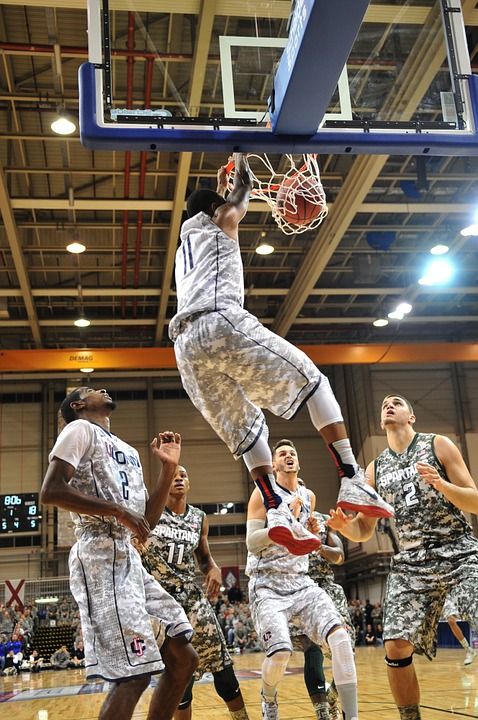 From time to time big schools such as these will have a tradition of having ‘tryouts’ for 1-2 walk-ons, but you must understand if you would become such a walk-on there is a chance you would never see any actual playing time.
From time to time big schools such as these will have a tradition of having ‘tryouts’ for 1-2 walk-ons, but you must understand if you would become such a walk-on there is a chance you would never see any actual playing time.
NCAA Division 2 and NAIA colleges and universities offer partial scholarships and are more readily acceptable to bringing in walk-ons to compete for roster spots. Also, as a walk-on you could work your way into gaining partial scholarships (partial tuition payment, books or meals, e.g.) the next year as these scholarship awards are reviewed by the college coaches and recruiters on a yearly basis. You may also decide to play at a NCAA Division 3 school, which under NCAA guidelines are not permitted to offer athletic scholarships.
How Many Basketball Scholarships Are Given Each Year?
If you have a desire to have a college basketball recruiter offer you a scholarship to play NCAA Division 1 basketball, you’re not alone. Nearly 4,500 players are on scholarship at the Division 1 men’s level while there are over 5,000 women basketball players with full rides to play college hoops.
NCAA Basketball Scholarships Limits
The NCAA requires universities and colleges at the D1 level to offer only ‘full’ scholarships in men’s and women’s basketball. Men’s programs are restricted to 13 scholarships while women’s program rosters have 15 full scholarship players. An interesting point for you to know about full scholarship awards at the NJCAA (Junior College) D1 level is the total offering includes transportation costs one time per year to and from the college by direct route. NCAA D2 and NAIA may offer full or partial scholarship monies to college basketball recruits. While NCAA Division 3 schools are not permitted to offer athletic scholarships you can also benefit from earning academic and merit scholarships available to all students registering to attend those institutions.
| # of Scholarships Limit per Team | Avg. Amount of Scholarship |
| Division | Men’s | Women’s | Men’s | Women’s |
| NCAA I | 13 | 15 | $16,154 | $17,114 |
| NCAA II | 10 | 10 | $6,329 | $7,650 |
| NCAA III* | N/A | N/A | N/A | N/A |
| NAIA | 11 | 11 | $7,329 | $7,762 |
| NJCAA | 15 | 15 | $2,479 | $3,002 |
The table above shows college basketball scholarships offered at the NCAA Division 1, NCAA Division 2, NJCAA, and NAIA levels.
Basketball Scouting: What do college basketball scouts look for in a player?
You must be aware there are several factors which college basketball recruiters consider before thinking of offering a student-athlete a basketball scholarship. Believe it or not, it all starts on the ability to find you. There are many ways to locate a potential basketball scholarship player:
- Getting players listed and profiled by recruiting services.
- Receiving recommendations from high school or club coaches.
- Searching Twitter for players of interest to competing colleges.
- Attending AAU Showcases & University-run camps.
Do YOU Fit the College Basketball Recruiter’s Player Traits?
Basketball scholarship monies are carefully handed out by college recruiters so each will carefully weigh numerous aspects involving you play. Are you tall your position at the college level? Are you finished growing? Is your body frame able to add more weight through college basketball conditioning programs? These are all ‘physically-related’ questions basketball recruiters are thinking about when they come to see you play or start watching the video your recruiting service has provided them.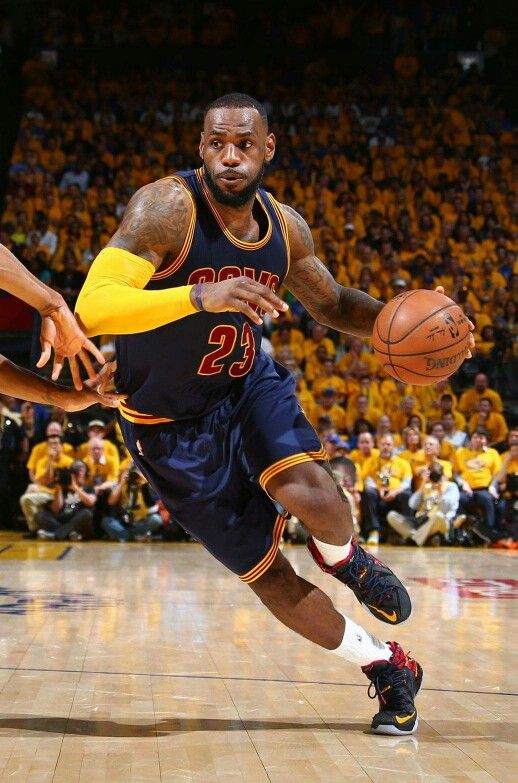
To answer on-court questions, basketball recruiters and coaches will create a checklist regarding your skills. For each part of the checklist, college coaches/recruiters will score you as being Strong, Fair, or Weak. You will be rated for: Boxing Out, Offensive Rebounder, Ball Handling, 1-on-1 Offense, Penetrator, Passing Skills, Quickness, Defense (on the ball), Defense (Away from ball), Spot Shooter, Free Throw Shooter, Aggressiveness, Leadership and Attitude.
Don’t forget your grades – including Overall Grade Point Average and ACT/SAT scores. Be sure you take the college entrance tests, and re-take them if you score poorly. The NCAA Eligibility Center guidelines are for prospective D1 and D2 student-athletes to follow. Strong grades are also important for D3 schools as academic scholarships are available for incoming athletes meeting the award criteria.
When Does Recruiting Begin?
Top collegiate programs will start sending basketball recruiters to watch you as early as when you are in middle school – IF YOU ARE A TOP-TIER TALENT.
How Many College Basketball Teams Are There?
Here is the total number of basketball programs at each division level.
Men’s Basketball Programs
There are approximately 1,844 men’s basketball teams in total.
- There are 344 NCAA division 1 teams in men’s basketball.
- There are 282 NCAA division 2 teams in men’s basketball.
- There are 403 NCAA division 3 teams in men’s basketball.
- There are 255 NAIA teams in men’s basketball.
- There are 560 NJCAA teams in men’s basketball.
Women’s Basketball Programs
There are approximately 1,834 women’s basketball teams in total.
- There are 335 NCAA division 1 teams in women’s basketball.
- There are 298 NCAA division 2 teams in women’s basketball.
- There are 426 NCAA division 3 teams in women’s basketball.
- There are 256 NAIA teams in women’s basketball.
- There are 519 NJCAA teams in women’s basketball.
Back to top^
The Average Height of College Basketball Players
These are the general guidelines for size requirements coaches look for in a basketball player.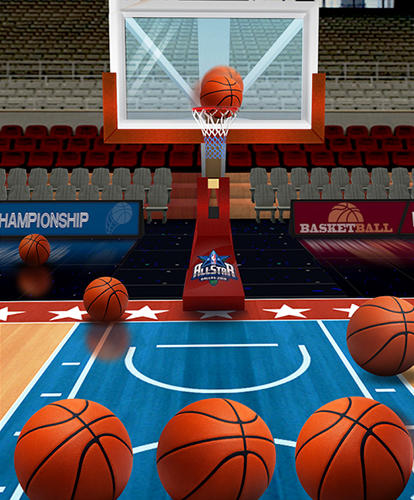 If you fall outside of these marks it doesn’t mean you can’t play at that level only that it might be more difficult.
If you fall outside of these marks it doesn’t mean you can’t play at that level only that it might be more difficult.
Men’s Basketball
| NCAA D1 | NCAA D2 | NCAA D3/NAIA | NJCAA |
| Point Guard | 6’1+ | 6’0+ | 5’10+ | 5’9+ |
| Shooting Guard | 6’3+ | 6’2+ | 6’0+ | 5’10+ |
| Small Forward | 6’5+ | 6’4+ | 6’3+ | 6’3+ |
| Power Forward | 6’7+ | 6’6+ | 6’5+ | 6’4+ |
| Center | 6’9+ | 6’8+ | 6’7+ | 6’6+ |
The average height of a men’s basketball player is 6’3”.
Women’s Basketball
| NCAA D1 | NCAA D2 | NCAA D3/NAIA | NJCAA |
| Point Guard | 5’8”+ | 5’6”+ | 5’5”+ | 5’6”+ |
| Shooting Guard | 5’10”+ | 5’8”+ | 5’6”+ | 5’8”+ |
| Small Forward | 5’11”+ | 5’10”+ | 5’8”+ | 5’9”+ |
| Power Forward | 6’0+ | 5’11”+ | 5’9”+ | 5’10”+ |
| Center | 6’2”+ | 6’0”+ | 5’11”+ | 5’11”+ |
The average height of a women’s basketball player is 5’6’”.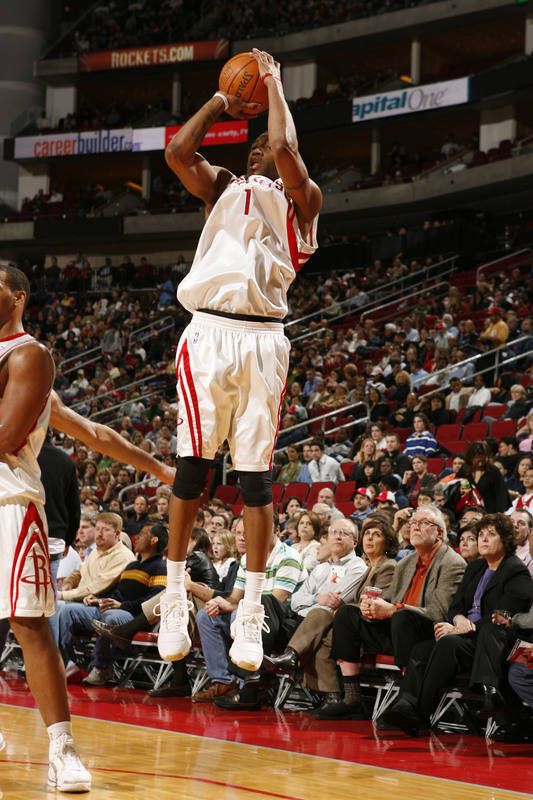
College Basketball Camps and Showcases
Do you know the difference between a basketball camp and a basketball showcase?
Basketball camps are summer camps run by colleges at all levels which have a basketball program. If you are serious about playing for a specific team, it is a great idea to attend one or more of these summer camps. Here’s why:
- You will be learning the game of basketball from established college coaches. These coaches may teach you something you haven’t learned from your high school or AAU coaches.
- Exposure – You get the opportunity to show you basketball skills to coaches who may not have heard of you. This exposure is not just to the coaches from the college where the camp is being held. Many times, especially with larger universities, outside coaches (from NCAA D2, D3 or NAIA, e.g.) will be hired to assist as camp coaches due to the sheer number of campers in attendance.
- Athlete interaction – You will get to talk with athletes from other high schools or AAU teams.
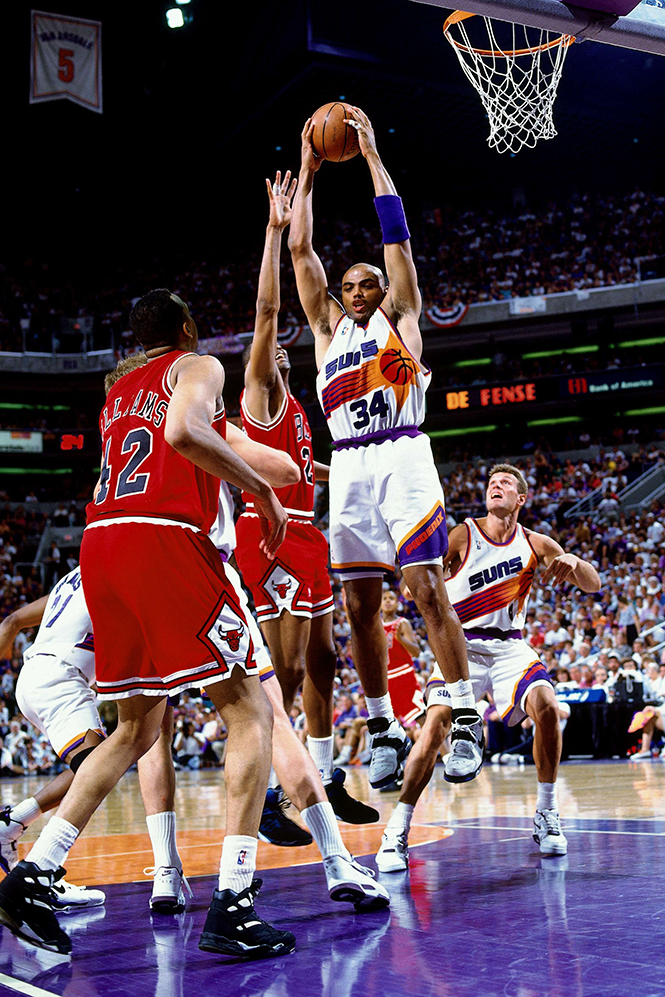 It could result in moving onto a better summer league team or gaining insight about recruiting experiences.
It could result in moving onto a better summer league team or gaining insight about recruiting experiences.
Showcases are events held, mostly during the summer, where you can play with other prospective college basketball recruits and display your court talents to college recruiters in attendance. While pricey this may be considered an investment for your desire to play basketball at the collegiate level. Most of these events will offer video of your games to assist in your recruiting process. Aside from possibly playing in front of college basketball recruiters, you will also get a better handle on your overall skills as you may be facing better competition than you do during your high school season.
Get more information about College Basketball Camps.
Choosing a college basketball camp can be a little difficult for you at first, but here are some tips to think about before making a final decision. You have to ask yourself the reason you want to attend a basketball camp.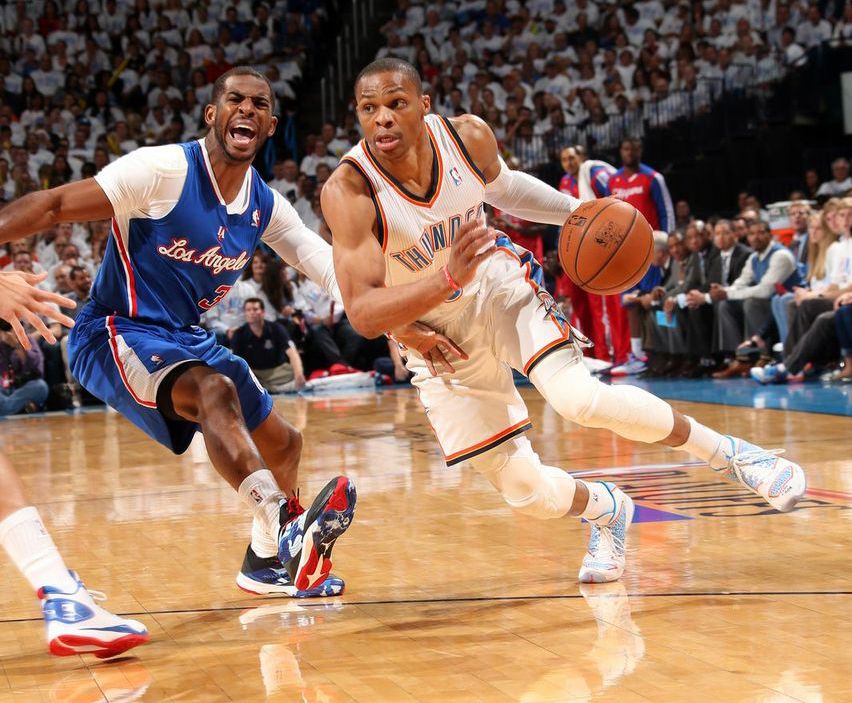
When is National Signing Day for Basketball?
National Letter of Intent, or National Signing Day as it’s more commonly called, is the specific time when you as student-athlete will decide which scholarship offer you will accept from a college basketball recruiter. For NCAA D1 schools, the next signing day is April 17, 2019 through May 15, 2019. The next period is November 13-20. If you are offered a ‘letter of intent’ you will have seven days to sign and return it to the university’s basketball department. The signed agreement means you will commit to playing for that college for at least one year. The college must also let you know each year if the scholarship has been extended. Even if you sign the letter of intent, you must also be able to meet all of the admissions requirements of the school before actually attending classes. Before signing, you need to be certain this is the school you want to attend. If you request a release from the agreement it may or may not be approved by the university.
Athnet is here to help you in your desire to play basketball at the collegiate level.
Through our many resources – including our website, free online profiles and various partnerships – we will provide you, the college recruit, as well as your family, easy-to-understand advice and subsequent resources to catch the attention from college recruiters. Recruiting and scholarship advice comes to you from our knowledgeable company representatives as each of them carries the experience of a former college coach or player. Your online presence is really a great way to start your recruiting experience. Did you know the vast majority (90%) of college recruiters start the process with an online search of student-athletes?
Build your free recruiting profile today!
420 thousand coaches are in our network of college recruiters and they will be looking at your latest video and statistics included in your profile. Don’t miss out on your chance to get the ‘early’ looks from college recruiters.
How women’s basketball started
Basketball history
Duke University Athletics
How to Get Recruited for College Basketball
Playing college basketball is the dream for thousands of student-athletes across the country. But many families are often unsure of how to go about getting recruited by coaches. To be successful, recruits need to research their best college fit and actively market themselves to these coaches by creating an online profile and highlight video that showcases their athletic ability and leadership qualities. This section will answer the most common questions families have on how to get recruited for college basketball.
Quick Links
How does college basketball recruiting work?
How to get recruited to play college basketball
Men’s basketball recruiting timeline
What do college basketball scouts look for in recruits?
What percentage of high school basketball players play in college?
How important is club basketball?
How to join a AAU basketball team: how does AAU basketball work?
What to know about college basketball walk ons
What is a preferred walk on in college basketball?
Do college basketball teams have tryouts?
How to prepare for basketball tryouts: What coaches look for in basketball tryouts
How tall are men’s college basketball players?
Attend basketball recruiting camps
What does redshirt mean in college basketball?
Learn how to make a college recruiting video for basketball
Research schools and create your target list
Contact coaches on your target list
How your high school coach can help you in your recruiting process
How does college basketball recruiting work?
Basketball recruits who are successful in their recruiting journey do the leg work: they build a list of realistic schools, create an online profile and highlight film, contact college coaches and compete in front of coaches at tournaments and camps. From a coach’s perspective, here’s a quick overview of how they find student-athletes:
From a coach’s perspective, here’s a quick overview of how they find student-athletes:
- Identify potential recruits. At any point in high school, coaches can send general materials, such as recruiting questionnaires, to student-athletes, and they usually send them out to a large number of freshmen and sophomores to gauge their interest in the program. Respond promptly to these materials.
- Second, in-depth evaluations. At this point, coaches focus on ranking their prospects and narrowing down their list. This is the stage where most families think the recruiting process begins. However, athletes who’ve made it this far have already passed an initial evaluation and shown some interest in the school. Tournaments, camps and highlight film are the most common ways coaches evaluate basketball prospects.
- Verbal offers and visits. After coaches have their list of ranked prospects, they extend offers and lock down verbal commitments.
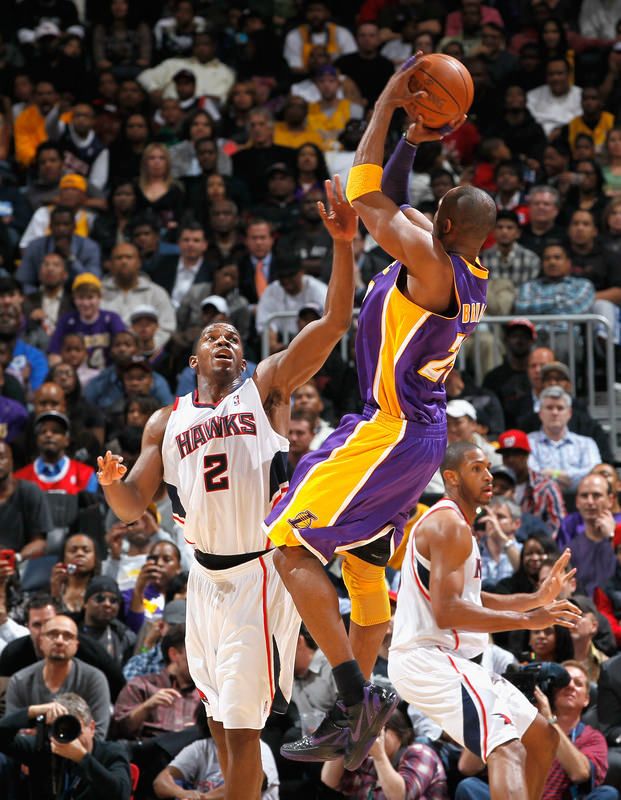 Many recruits who are being seriously recruited will partake in unofficial and official visits during their junior and senior years.
Many recruits who are being seriously recruited will partake in unofficial and official visits during their junior and senior years.
Related Articles
- What are my chances of being part of Illinois basketball recruiting?
- Basketball College: Offering Scholarships and On-Court Glory
- How are NCAA basketball teams organized?
How to get recruited to play men’s college basketball
Recruiting isn’t a linear, clear-cut process. You could be nearing the end of your conversations with one coach, while simultaneously just beginning with another. But knowing what steps you can take to create a communication strategy and market yourself will help you secure a scholarship offer.
- Research and build a target list. Student-athletes should visit college rosters and look at the players in their position (are they seniors who are graduating?), athletic stats (how do they measure up?) and backgrounds (does the coach recruit from a particular region or tournament?).
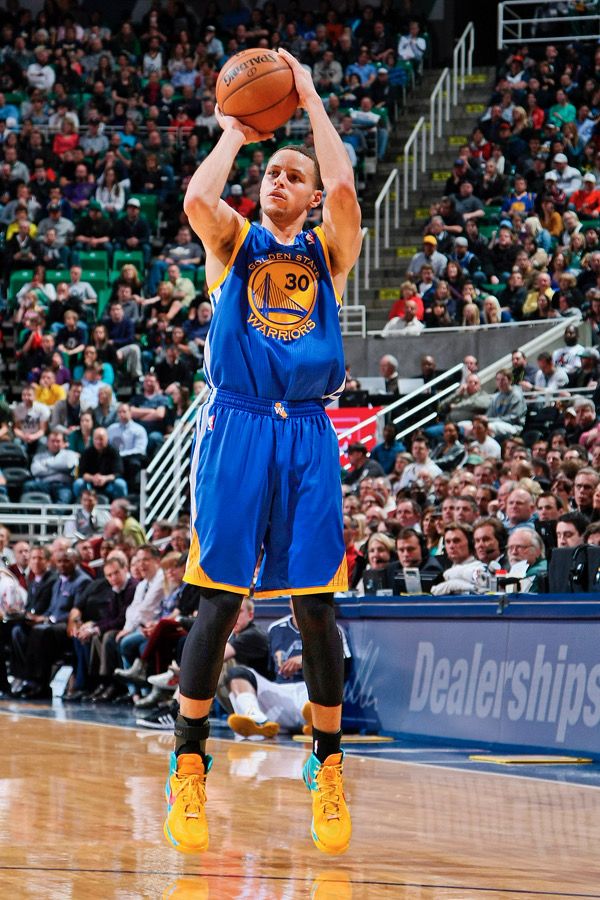
- Compete at the highest level possible: To accurately assess a recruit’s ability to compete in college, coaches want to see them play against high-ranked athletes.
- Compete in the summer during live periods: Scheduling conflicts make it difficult for college coaches to watch recruits play in-person during the regular season. So, they turn to live periods. These stretches in the offseason allow college basketball scouts and coaches to hit the road and scout several players at once. Attend elite or exposure camps as well.
- Excel academically. The NCAA Eligibility Center determines the academic eligibility and amateur status for all NCAA Division 1 and Division 2 athletes. Understand the requirements to stay on track.
- Create a highlight film. The best way to secure an in-depth and in-person evaluation is by sending coaches a highlight video and a full game film. It’s a quick way to show a snapshot of the recruit’s skill set.
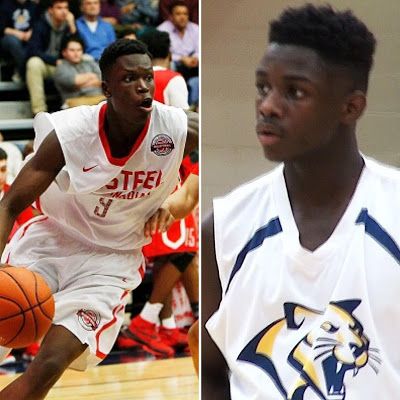
- Be proactive. Start by sending an introductory email that includes your online profile, highlight video, academic information, outstanding athletic achievements and personal interest in the program. Then follow up with a phone call.
Men’s basketball recruiting timeline broken down by year in school
Here is a general guideline you can follow year-by-year to ensure your family is on track.
Freshman year
- Fill out questionnaires online and respond to coach materials. College coaches can send recruits general materials, such as questionnaires, camp information, non-athletic information about the school and materials published by the NCAA at any time.
- Meet with your guidance counselor and set academic goals for the year to keep your academic eligibility on track.
- Research colleges from all division levels.
- Create an online profile and if you have varsity or high-level competitive film, post your highlight video.

- Be proactive and call Division 1 and Division 2 coaches or athletics staff and talk to them on the phone.
Sophomore year
- Post your highlight video to your online profile, if you haven’t already.
- Aug. 1—Recruits can begin taking unofficial visits to Division 1 schools.
- Check that your sophomore year classes meet NCAA academic eligibility standards and register for the NCAA Eligibility Center.
- Send introductory emails to college coaches at your target colleges, if you haven’t already. And follow up with a phone call.
- NCAA Division 1 and Division 2— Student-athletes can receive personal contact and recruiting materials starting June 15 after their sophomore year. Coaches can call athletes, send text messages, direct messages and emails, as well as make verbal offers. Top Division 1 and Division 2 athletes are getting offers from college coaches at this time. Most Division 1 rosters are finalized before the start of junior year.
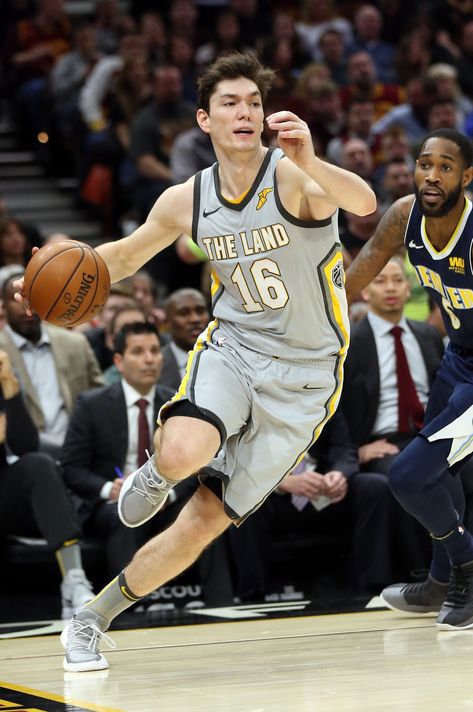
- NCAA Division 3—Off-campus contact is allowed after sophomore year.
Junior year
- Take the ACT or SAT and submit your scores to the NCAA Eligibility Center. Upload your transcript to the Eligibility Center as well.
- Update your highlight video.
- NCAA Division 1—Off-campus contact is allowed beginning your opening day of classes.
- NCAA Division 1—Official Visits are allowed Aug. 1 of your junior year through completion of junior year (5 total visits).
- NCAA Division 3—Official visits allowed starting Jan. 1 of junior year.
- Offers continue to roll in for Division 2 prospects, as well as Division 3 and NAIA athletes.
- If you’re not getting interest from coaches at the schools you’ve been contacting, take a new look at your college list and find new opportunities.
Senior year
- Update your highlight video.
- NCAA Division 1—Recruits can take an additional five official visits during their senior year.
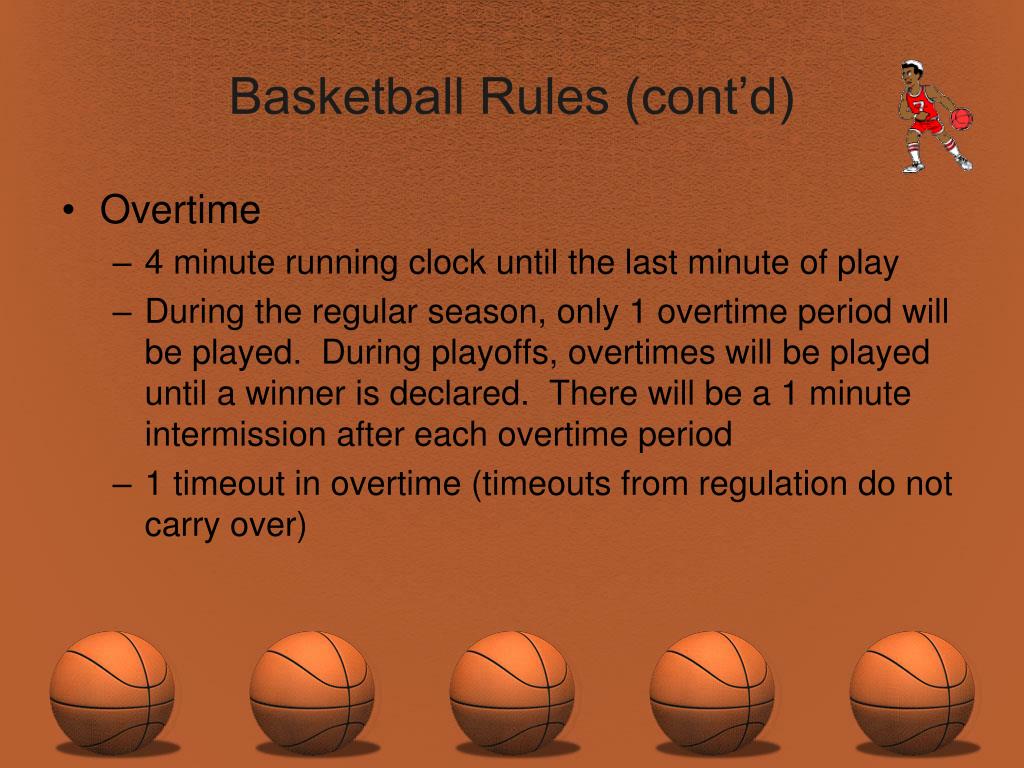 They may re-visit a school from a junior year official visit.
They may re-visit a school from a junior year official visit. - Nov. 13-20—Early signing period for NCAA Division 1 and Division 2 schools begins.
- Nov. 1—NJCAA Signing Date.
- Apply for the FAFSA on Oct. 1.
- Register with the NAIA Eligibility Center.
- Request final amateurism certification beginning April 1 in NCAA Eligibility Center account.
- April 15-May 20—Regular signing period occurs for Division 1 and Division 2.
- Division 3 and NAIA teams are finalizing their rosters during senior year. JUCO programs are also recruiting student-athletes at this time. Consider these schools if you haven’t secured a roster spot yet.
What do college basketball scouts look for in recruits?
College coaches consider a few factors when determining an athlete’s ability.
- Physical characteristics—height and body frame, athleticism and strength. In NCAA Division 1 men’s basketball, the average height of a college basketball player was just under 6’5” and the most common height listed was 6’7”.
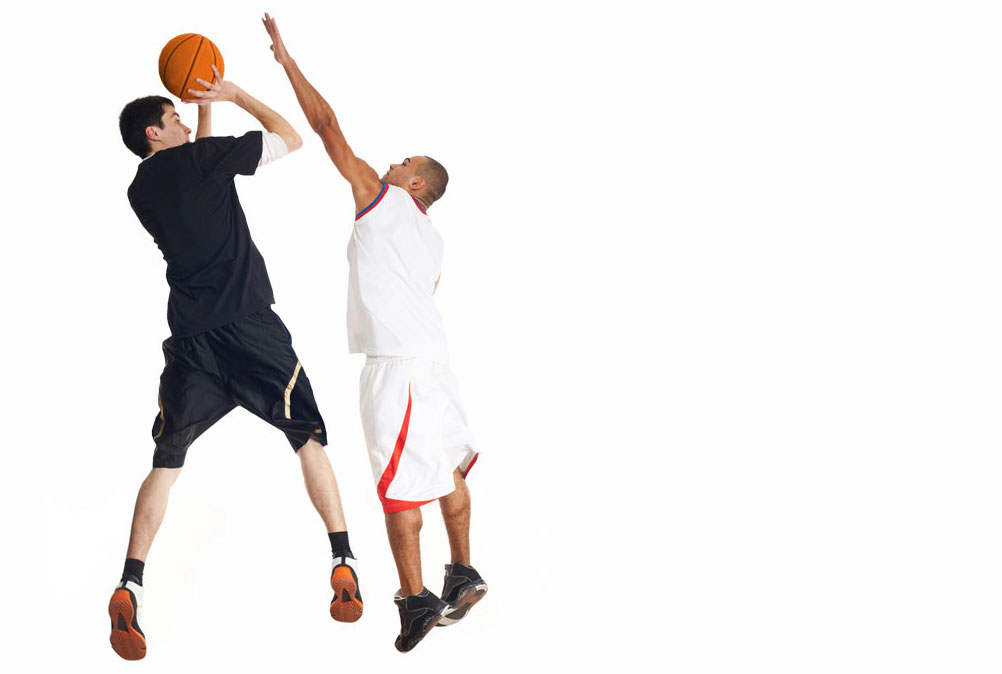
- Technical skills. Coaches want to recruit student-athletes who have mastered the fundamentals.
- Basketball IQ. Can the student-athlete process information in real time during a game and make the right decisions?
- Academics. College coaches look for recruits who excel in the classroom. They know that student-athletes with a solid GPA and test scores will more likely be admitted into their university and have an easier college transition. Plus, a good GPA also tells coaches that the recruit is responsible and disciplined—traits they highly value.
Of course, what coaches look for also depends on their program’s specific needs. Connecting with a college coach is the best way to understand what kind of recruit they need. Another quick way is to visit the team’s website and analyze their roster.
What percentage of high school basketball players play in college?
There are 551,373 high school men’s basketball players.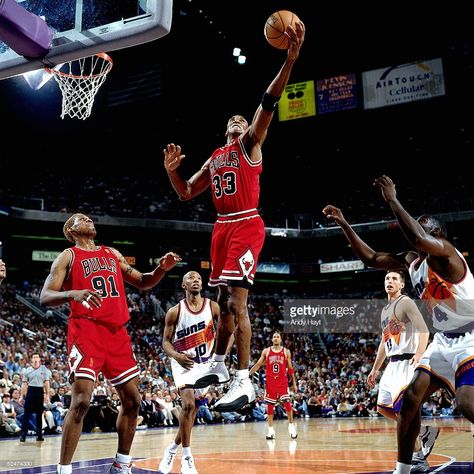 Of that number, 18,540 —or 3.4 percent—go on to compete in the NCAA and less than one percent move on to the NAIA. Just less than one percent compete in NCAA Division 1 where there are 353 teams; one percent compete at the NCAA Division 2 level, which has 313 programs; and 1.4 percent compete at NCAA Division 3 with 109 teams. There are 430 JUCO programs rostering 6,352 basketball players.
Of that number, 18,540 —or 3.4 percent—go on to compete in the NCAA and less than one percent move on to the NAIA. Just less than one percent compete in NCAA Division 1 where there are 353 teams; one percent compete at the NCAA Division 2 level, which has 313 programs; and 1.4 percent compete at NCAA Division 3 with 109 teams. There are 430 JUCO programs rostering 6,352 basketball players.
How important is club basketball in the college basketball recruiting process?
AAU, which stands for the Amateur Athletic Union, can be a valuable tool in gaining exposure to college coaches. It allows recruits to compete against top tier athletes and offers coaches an extended look into their abilities. Elite Division 1 basketball players are often recognized in middle school through their AAU experience. But even though AAU provides several competitive opportunities, it isn’t a requirement to obtain a college basketball scholarship. Several prospects have foregone the AAU circuit and moved on to successful college and professional careers.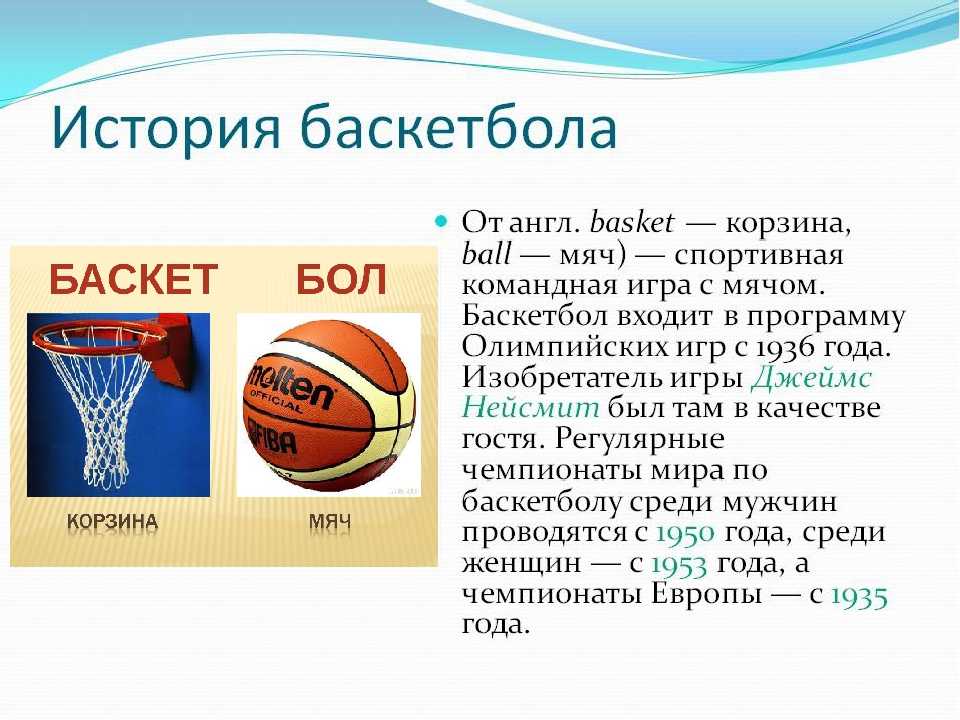
How to join a AAU basketball team. How does AAU basketball work?
AAU is a youth sports organization and stands for the Amateur Athletic Union. Athletes form independent teams and compete in AAU tournaments against other teams. Teams are assigned based on geography. To find out which district you belong to and which team is best for you, you can visit the AAU website.
Many athletes value AAU as it provides an opportunity to compete against top-level talent that you typically wouldn’t find by solely playing locally. There are various levels of competition within AAU and as players develop and get better, they’ll switch to a higher competitive team. As a result, many AAU tournaments, especially NCAA-certified tournaments, often attract scouts, giving athletes a chance to play in front of college coaches. However, participating in these events can be costly. The AAU membership fee is $14 per year, but families can end up paying $400 to $4,000 dollars per year depending on how many tournaments they travel to. Many programs, however, offer financial assistance to help cut the high price tag associated with AAU.
Many programs, however, offer financial assistance to help cut the high price tag associated with AAU.
Do college coaches recruit at AAU or high school games? The answer is, both. But joining an AAU program and competing during the off-season gives recruits the advantage to be seen by college scouts year round. It can be difficult for college coaches to attend many high school games during the regular season because of their competing schedules. AAU tournaments provide college coaches the opportunity to evaluate many recruits at one time.
To get a membership or start a club, you can visit AAU’s website.
What to know about college basketball walk ons and how to walk onto a college basketball team
The first thing you should know about becoming a college basketball walk-on is that it is rare. Basketball rosters are not that big—there’s an average of 17 players per team across the divisions. Coaches aren’t going to give up spots to walk-ons if they don’t have to.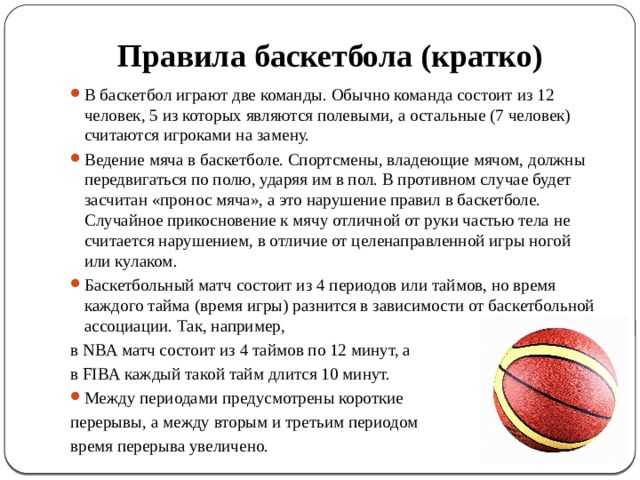 Some student-athletes, though, are recruited as a preferred walk-on. These athletes go through the recruiting process and are offered a roster spot, but they don’t receive any athletic aid as the coach doesn’t have any scholarship opportunities available.
Some student-athletes, though, are recruited as a preferred walk-on. These athletes go through the recruiting process and are offered a roster spot, but they don’t receive any athletic aid as the coach doesn’t have any scholarship opportunities available.
Student-athletes have a better chance of walking on to a college team as a preferred walk-on compared to going to a tryout and making the team. Preferred walk-ons take all the necessary steps in the recruiting process to capture a coach’s attention: they proactively contact coaches and send their online resume; they attend camps and tournaments to gain exposure; they reach out to schools that are the right academic and athletic fit for them; and they take unofficial visits to the college.
Learn more about becoming a walk-on versus getting a scholarship offer.
What is a preferred walk on in college basketball?
After college coaches have handed out all of their scholarship opportunities, they may still continue to recruit student-athletes. In this scenario, a student-athlete is guaranteed a roster spot without receiving any athletic aid. These are known as preferred walk-ons. The recruit still goes through the recruiting process and joins the team—the coach just doesn’t have an athletic scholarship available for them.
In this scenario, a student-athlete is guaranteed a roster spot without receiving any athletic aid. These are known as preferred walk-ons. The recruit still goes through the recruiting process and joins the team—the coach just doesn’t have an athletic scholarship available for them.
Being a preferred walk-on means something different depending on the division and program, though. In NCAA Division 1, walk-ons typically don’t see much playing time and are less likely to receive an athletic scholarship in subsequent years. At the NCAA Division 2 and JUCO levels, however, some walk-ons earn playing time and a scholarship going into their second season. It is best to have clear communication with the college coach to understand playing and scholarship opportunities.
Do college basketball teams have tryouts?
While NCAA Division 1 and Division 2 programs are allowed to conduct basketball tryouts, Division 3 cannot do so. Tryouts are limited to prospective student-athletes who are seniors in high school, junior college transfers or four-year transfers who have completed their basketball season. Tryout participants also must be on an official or unofficial visit to the campus.
Tryout participants also must be on an official or unofficial visit to the campus.
Typically college coaches only recruit one to two players as walk-ons. In Division 1, walk-on athletes don’t receive athletic aid and usually don’t get any playing time. Division 2 and JUCO programs more commonly give walk-ons a chance at competing for a roster spot and because these divisions offer partial scholarships, there’s also a chance to earn athletic aid after the first year.
How to prepare for basketball tryouts and what coaches look for in basketball tryouts
When making roster decisions, college coaches consider a recruit’s physical characteristics, like height and body frame, athleticism, ability to execute the fundamentals and basketball IQ, which showcases the athlete’s ability to interpret what is happening at game speed, as well as their ability to make the right decision based on instinct and experience. These players can anticipate what will happen next, making their game more automatic.
Securing a roster spot at a tryout is extremely rare. Student-athletes will improve their chances of walking on to a college team by establishing a relationship with the college coach ahead of time. Send them an introductory email with highlight film, game film, academic information, and contact information.
How tall are men’s college basketball players?
The height of men’s college basketball players vary slightly from division to division. Generally, men’s basketball players are between 5’9” and 6’9”. Keep in mind that this should be used as a helpful guideline and not something set in stone. Players who don’t fall within these ranges are recruited every year by college coaches. The best way to understand a coach’s recruiting needs is to establish a relationship with them early on and analyze their current team roster.
View the average height of men’s basketball players by position across each division level.
Attend basketball recruiting camps to get noticed by college coaches
Here are a few factors to consider when choosing the right camp:
- College basketball camps are run by the college’s basketball program.
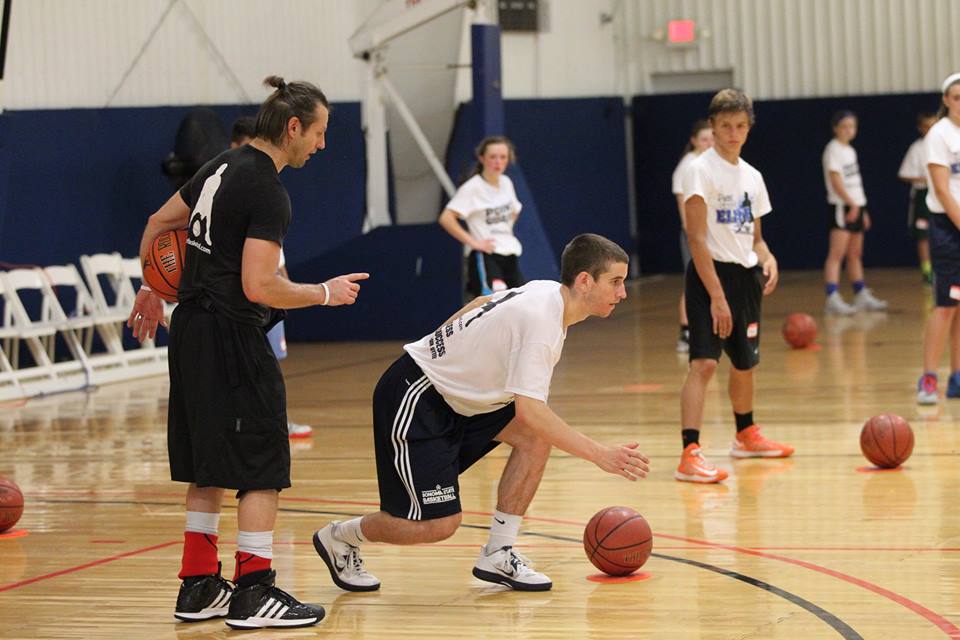 Student-athletes have an opportunity to sample campus life and compete in front of the coach.
Student-athletes have an opportunity to sample campus life and compete in front of the coach. - Basketball exposure camps are designed to evaluate players and obtain a player ranking. Although they are not tied to a specific university, many basketball exposure camps offer players an opportunity to play in front of college coaches, especially at NCAA DIII men’s basketball coaches. Many of these camps are invitation-only, so the talent level is high – and excellent for player development.
- Lastly, there is a level of “elite camps.” These are typically invitation-only events that bring together the top recruits from each graduate class to compete against each other at a national level. They’re run by college coaches on the school’s campus, so they’re a great way for athletes to get exposure to coaches.
If you want to get recruited at a college basketball camp, remember that most coaches attend events only to see players with whom they’ve already made some kind of connection.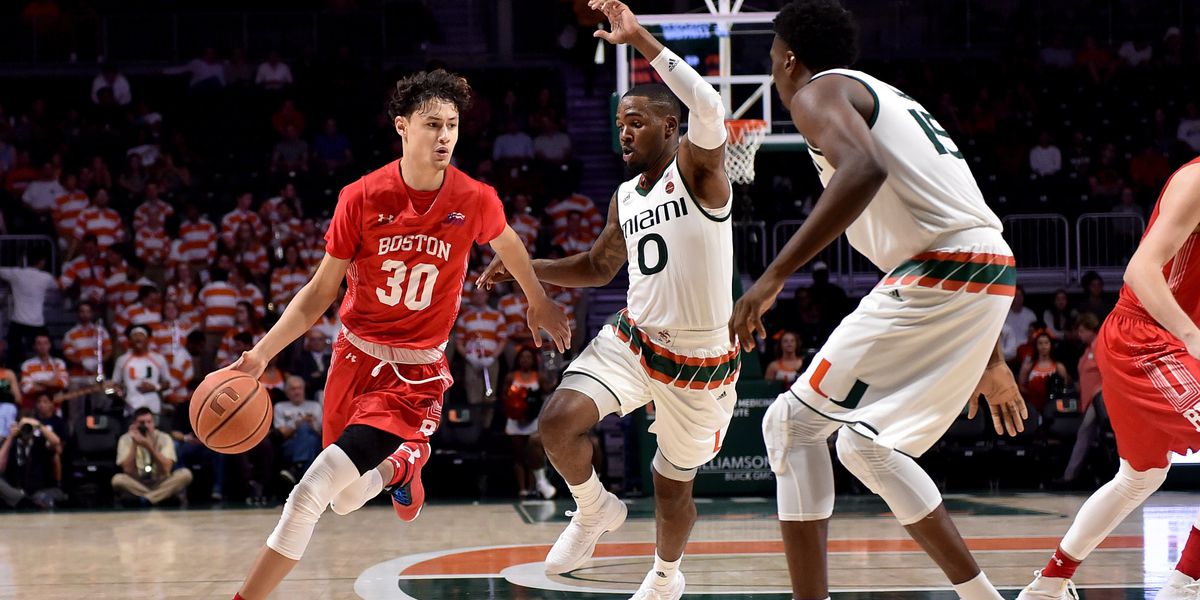
Learn more about basketball camps and search for the best camps.
What does redshirt mean in college basketball?
The term “redshirt” is used to describe a student-athlete who does not participate in outside competition for an academic year. They’re allowed to practice and train with the team, but they don’t see any playing time. By doing this, they gain an additional year of eligibility, so technically they play four seasons in five years. Some coaches offer redshirt scholarships to freshmen who don’t meet the academic eligibility requirements coming out of high school, or as a chance to physically grow and prepare to compete as a collegiate athlete. In some cases, student-athletes redshirt for a year as they recover from an injury.
Learn how to make a college recruiting video for basketball
Creating a basketball highlight video is essential to garnering coach interest. Follow these straight-forward tips to put together a video that truly stands out:
- Choose games against your best competition, such as varsity level, high-level AAU games or any nationwide tournaments.
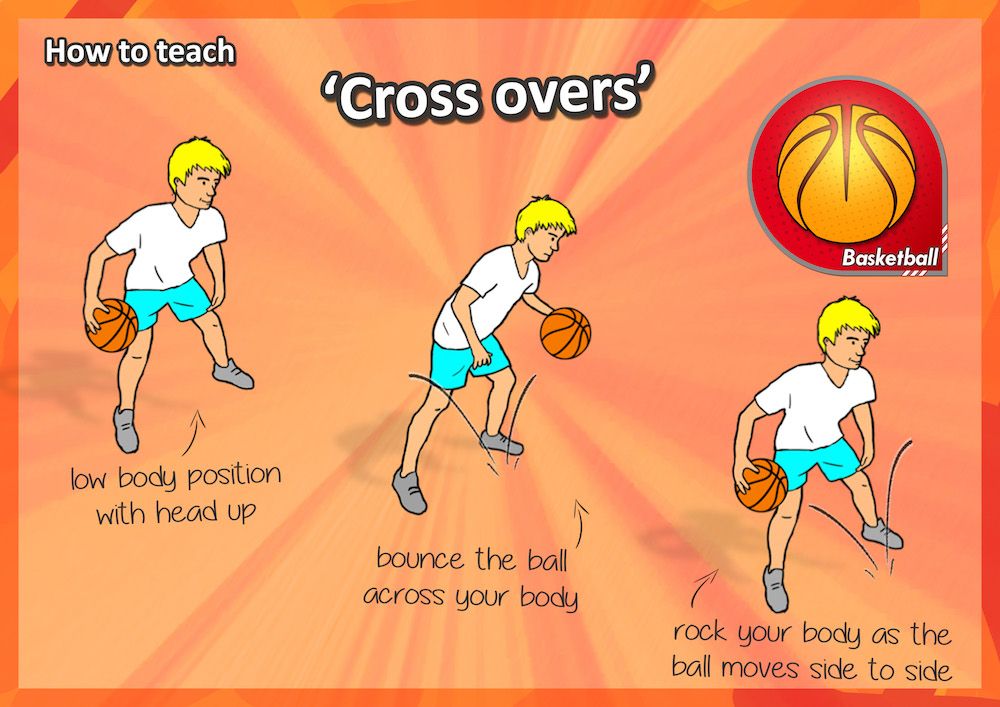
- Focus the camera from mid-court while making sure the student-athlete is easily recognizable.
- Use a tripod to avoid a shaky camera.
- Don’t zoom in and out.
- Make sure the person filming the match isn’t cheering. If there is excessive and distracting background noise, mute the video completely. Don’t add music to the video either.
- Put a title card at the front of your basketball highlight video that includes your name and graduation year, such as “John Doe Basketball Recruiting Video Class of 2021.”
- Stack your best clips first. Typically you’ll start your video by highlighting your shooting ability.
- Focus on three or four strengths and organize your clips to highlight them. For example, if you’re an excellent three-point shooter, highlighting six straight threes is much more effective than showcasing one three-pointer, a pass, then a free throw, and then maybe another three, etc.
- Know what coaches are looking for in your position.
 In short, post players should showcase their shooting ability, quickness, ability to finish at the rim, rebounding, shot blocking, footwork and overall basketball awareness. Perimeter players should focus on scoring ability, quickness, ability to penetrate and finish at the rim, athleticism, basketball awareness and court vision.
In short, post players should showcase their shooting ability, quickness, ability to finish at the rim, rebounding, shot blocking, footwork and overall basketball awareness. Perimeter players should focus on scoring ability, quickness, ability to penetrate and finish at the rim, athleticism, basketball awareness and court vision. - Cap your video with your best 20 to 30 clips and keep it under four minutes.
- Send college coaches your highlight video, as well as one unedited full game video. If they’re interested in a recruit after watching their highlight film, they will want to evaluate the full game next.
See the full list of tips for creating a basketball highlight video.
Research schools and create your target list
The very first step in the recruiting journey is often the one most overlooked—research. Here are the most important factors to keep in mind:
- Academics: Visit the school’s website to see the average grades and test scores.
 Plus, consider which majors are offered and remember to ask the coach which majors are popular among athletes on the team.
Plus, consider which majors are offered and remember to ask the coach which majors are popular among athletes on the team. - Athletics: Student-athletes can use their high school or club coach to help them assess where they can make an impact, or they can visit a team’s roster and analyze the athletes’ key stats.
- Cost: How much can your family afford and how much aid is the student-athlete eligible to receive at each school? NCAA Division 1 schools offer full ride scholarships, while Division 2, NAIA and JUCO programs offer partial scholarships. Many coaches, including NCAA Division 3, work with the admissions department to create financial packages that include need-based aid, grants, academic scholarships, work study and merit-based scholarships.
- Personal Preferences: Think about housing options, school size, social aspects, distance from home and even the weather.
As families start to find programs they’re interested in, we recommend sorting them into three categories: target schools, dream schools and safety schools. Most of the schools on a student-athlete’s list should fall into the target category.
Most of the schools on a student-athlete’s list should fall into the target category.
Get a head start on your list by viewing NCSA’s list of Best Colleges for Student-Athletes.
Contact coaches on your target list
Once a recruit has done the research and built a realistic target list of colleges, they’re ready to contact coaches. Remember—never wait for a coach to reach out. Be proactive to get on their radar. Here are a few steps to take:
- Send an introductory email: An introductory email serves two purposes—to get an initial evaluation and establish a relationship with the coach. Make sure this email includes highlight film, academic information, contact information and key stats. Student-athletes should also personalize their email and explain their interest in that specific program. Never copy and paste—it’s almost guaranteed to get skipped over.
- Tailor the subject line: Avoid generic subject lines, such as “Top basketball recruit,” and tailor the subject line to the school instead.
 For example, a recruit might want to include their GPA and test score in the subject line for high academic colleges, while highlighting key stats or awards to Division 1 schools.
For example, a recruit might want to include their GPA and test score in the subject line for high academic colleges, while highlighting key stats or awards to Division 1 schools. - Call coaches. Basketball coaches are allowed to talk to athletes on the phone when the recruits are the ones initiating contact. In other words, if a recruit calls an NCAA Division 1 coach, the coach is allowed to talk to them. Typically, they’ll want to email them letting them know what time they plan on calling so the coach can be prepared
- Follow up. Whenever there is a noteworthy update to share, like a new ACT or SAT score or athletic achievement, email the college coach again to touch base. Because if they missed the first email (and coaches tend to be pretty busy), following up can help keep you top of mind.
See the full list of tips on contacting coaches.
How your high school coach can help you in your recruiting process
High school or club coaches are there to support student-athletes along their recruiting journey—and help them connect with college coaches. Here are a few ways:
Here are a few ways:
- Find the right college fit: Use their expertise and insight to create a college list of realistic programs. Plus, they probably have connections in the college network.
- Connect with college coaches: There’s a loophole in the NCAA basketball recruiting rules that allows student-athletes and college coaches to talk on the phone. If a student-athlete initiates the contact and calls the college coach, the coach is allowed to answer the phone and talk to the recruit. High school coaches can help facilitate this contact by acting as a liaison.
- Character reference: Men’s basketball coaches want to learn as much as they can about their top recruits, including their leadership qualities, attitude and talent. So, they call the recruit’s high school or club coach to get a better understanding of the athlete’s mental toughness, work ethic and behavior both on and off the court.
- Video help: Don’t hesitate to ask your coach for help when creating a highlight film.
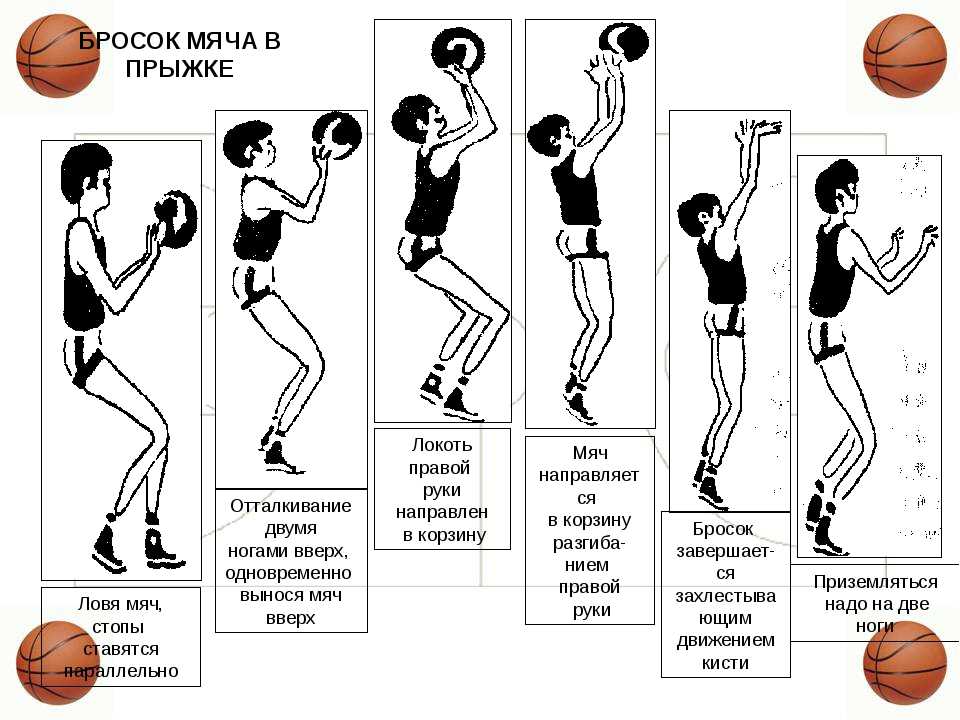 Plus, they probably have full game footage already available.
Plus, they probably have full game footage already available.
Insider tip: Despite the impact that coronavirus had on college sports, as of June 1, 2021, the NCAA resumed its regular recruiting rules and activity! Coaches are actively working to fill their rosters, so student-athletes should be proactive in reaching out to coaches. Read up on how the extra year of eligibility granted to athletes who were most affected by the pandemic in 2020 will impact future recruiting classes.
Basketball - Quick Guide - Tutorialspoint He developed a sport based on his childhood game
Duck on a Rock where players have to hit a rock called a duck in the game. The duck has been protected by other players and placed high on a rock.
He also wanted the game to be safer, so the sport was played with soccer balls and peach baskets placed about 10 feet high, with less physical contact, drawing the players' attention to the ball rather than other players. He developed thirteen rules, and the first match took place on December 21, 1891 year among two teams of nine players at Springfield College.
He developed thirteen rules, and the first match took place on December 21, 1891 year among two teams of nine players at Springfield College.
The rules of the game have been changed a bit and many more rules have been added to make it better and more interesting over time. The actual game did not allow dribbling, used closed baskets, and was played on a smaller court. The game was originally played in YMCA gyms. The YMCA helped spread the game to other parts of America, and the game also increased YMCA membership. It was popularized by cable television and distributed to other parts of the globe by North American soldiers fighting in World War I.
Basketball - Purpose
The main purpose of basketball is to make a goal and score points. The goal is achieved by shooting the ball through the basket or hoop. The goal post or basket for the team is on the opponent's court. Each team must not only try to set a goal and prevent the opposing team from taking control of the ball, but must also try to protect the basket in their own court and prevent the opponent from scoring a goal.
Basketball - Team size
Each team may have twelve players eligible to play the game. Five players per team may play at any time on the court and they may be substituted at any time during play. Each team may have a coach and an assistant coach. Each team may have a group of less than five non-playing players with different responsibilities. Usually this is a manager, a doctor, a physiotherapist, a statistician and a translator.
Participating countries
Since basketball originated in the United States, it is very popular in the country and has spread to other neighboring countries. The NBA should be credited for expanding the game and building a huge fan base around the world.
China has dominated the Asian Basketball Championship and won many titles. Basketball is the most popular sport in the Philippines. Iran, South Korea and Japan are also good competitors for China in the Asian Basketball Championship. Russia defeated the USA in the 1972 Summer Olympics and attracted worldwide attention.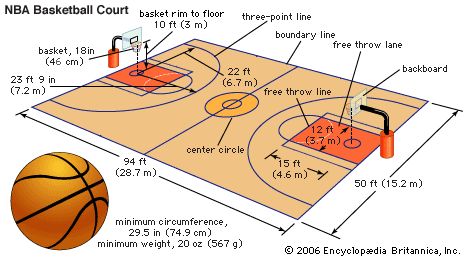
Some of the countries that have produced basketball champions are: Greece, Lithuania, Serbia, Spain, France, Canada, USA, Brazil, Italy, Argentina and Montenegro.
There are many variations of basketball, some are indoors and some are outdoors, some are played on larger courts and some teams have more players. We can play a fun game on any flat surface, but FIBA, the organizing body, has made some rules for the basketball court.
Court Design
The standard international basketball court is a 50' x 94' indoor rectangular court.
School courts may be smaller. The court is divided into two symmetrical halves, one for each team. Various markings are drawn on the site. There is a circle in the center, free throw semi-circles, restricted areas and three-dot lines marked on either side of the court. Directly below the basket is a free semi-circular zone.
Basketball is a simple game that requires no equipment other than a hoop, ball and flat court. Even two players can play and have fun playing basketball.
Even two players can play and have fun playing basketball.
baskets
A hoop or basket with a perimeter netting, 18 inches in diameter, is tightly suspended horizontally from a rectangular backboard 3.5 feet high and 6 feet wide on both sides of the court. The rim of the hoop is 10 feet above the ground. The shield in various international competitions is transparent for better visibility.
Ball
A basketball is a spherical ball that is orange in color and has a rough texture with black outlines, usually made of leather or complex rigid materials.
The ball continuously bounces (dribbling), thrown through the air to other players (passing) and towards the basket (shooting). Thus, a typical basketball must be very durable and easy to handle.
Other equipment
Other equipment may be available for convenience.
-
Some international courts have a game clock, which beeps at the end of each period.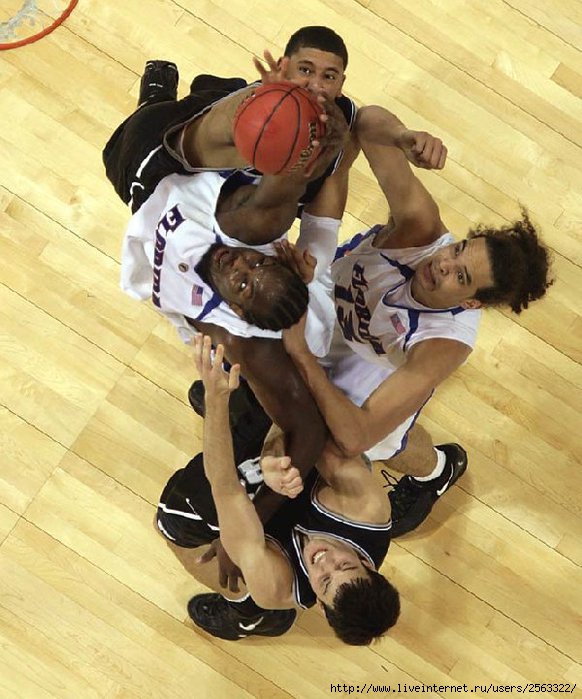 Some also show a countdown.
Some also show a countdown.
-
Sometimes there are limit lights on the rear panels, which light up to indicate that the period is ending.
Some international courts have a game clock , which beeps at the end of each period. Some also show a countdown.
Sometimes there are limit lights on the rear panels that light up to indicate that the period is ending.
We have listed here some common terms commonly used in basketball
-
Offending team - The team in possession of the ball is the offending team.
-
Defensive team - A team that is not in possession of the ball and tries to control it is the defensive team.
-
Shot Hours – Shot Hours shows the amount of time allowed for the attacking team to reach the target. If a team fails to make a goal, it is a tact violation and the ball is passed to the opposing team for a throw-in.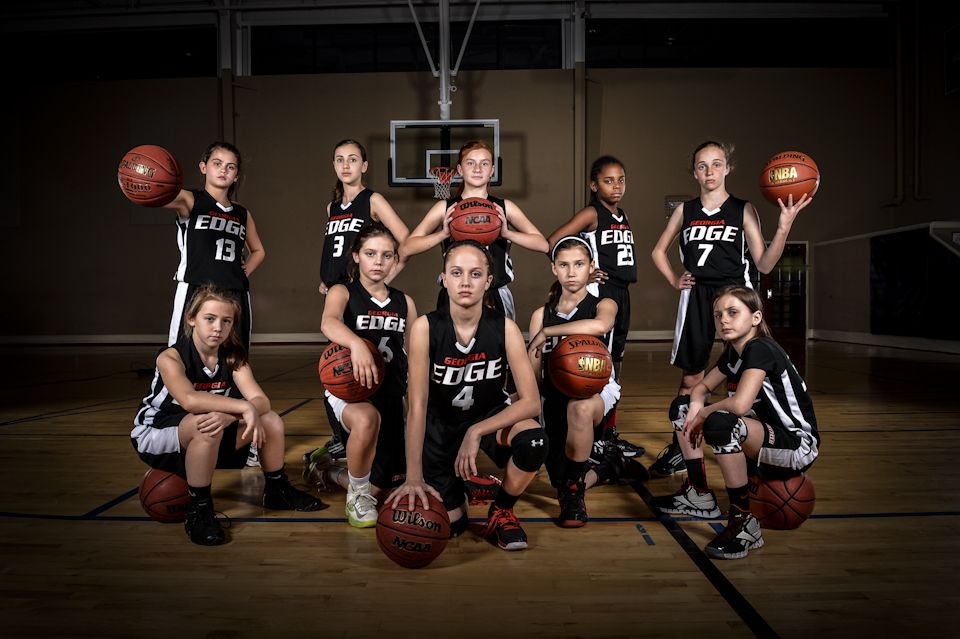 The clock is usually set to 24 seconds in FIBA and NBA matches. The clock returns to the full limit when the ball touches the basket or passes through the basket. In some cases, after a foul, the shot clock is usually set to a lower number, 14 in NBA and FINA matches.
The clock is usually set to 24 seconds in FIBA and NBA matches. The clock returns to the full limit when the ball touches the basket or passes through the basket. In some cases, after a foul, the shot clock is usually set to a lower number, 14 in NBA and FINA matches.
-
Key - Painted area 16 feet wide on professional basketball courts.
-
Basketball Pistol - This ball pistol shoots basketball back at the player. Used during training.
-
Dunk Shot - A player makes a dunk shot while jumping and pushing the ball through the basket.
-
Free Throw - When a player is granted a free throw, he/she may attempt to score from 15 feet without any obstruction from the opposing team. Free throws are also awarded to the opposing team when a player commits technical fouls.
-
Penalty situation - A team is in a penalty situation if it commits five fouls in one quarter.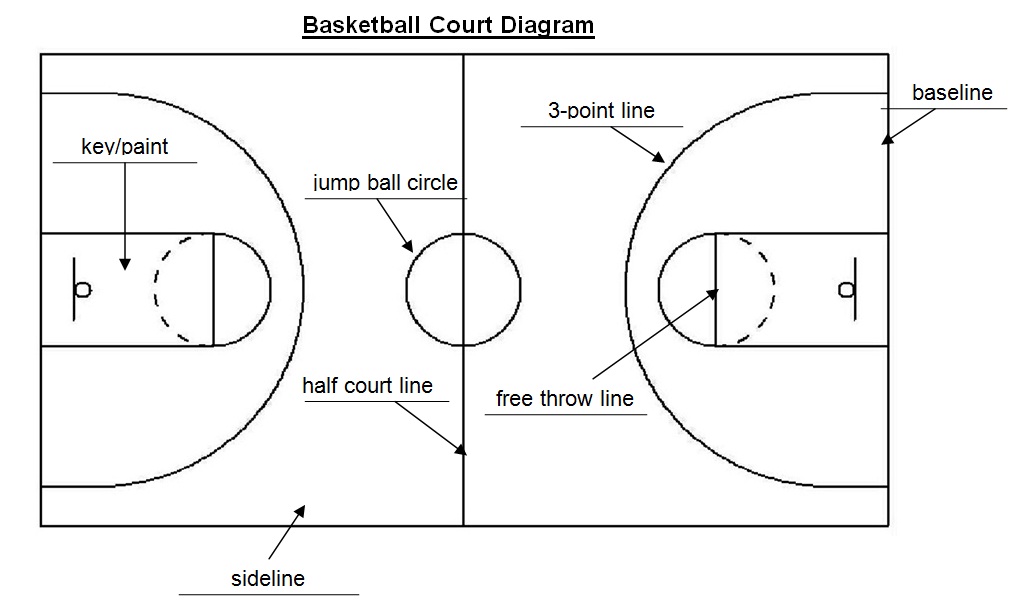 The penalty gives free throws to the opposing team after a foul.
The penalty gives free throws to the opposing team after a foul.
-
Ball held. Sometimes a player is surrounded by too many opponents and cannot pass the ball to any of his teammates. He has a firm grip on the ball and sometimes even one of his opponents can hold the ball at the same time. To take control of the ball, one of them must grab it with force. This situation is called a held ball.
-
Ball bouncing - The referee may call for a ball to be thrown to deal with a ball holding situation and get the ball back into play. The referee also starts the game with a jump ball. A ball is thrown vertically into the air between two opponents. Either of them pushes him towards a teammate.
-
Point Guard, Shooter, Small Forward, Power Forward, Center are the different positions of the team members. They are not required to occupy a specific position, and the team may refuse command positions. It is sometimes used to get attention and please viewers.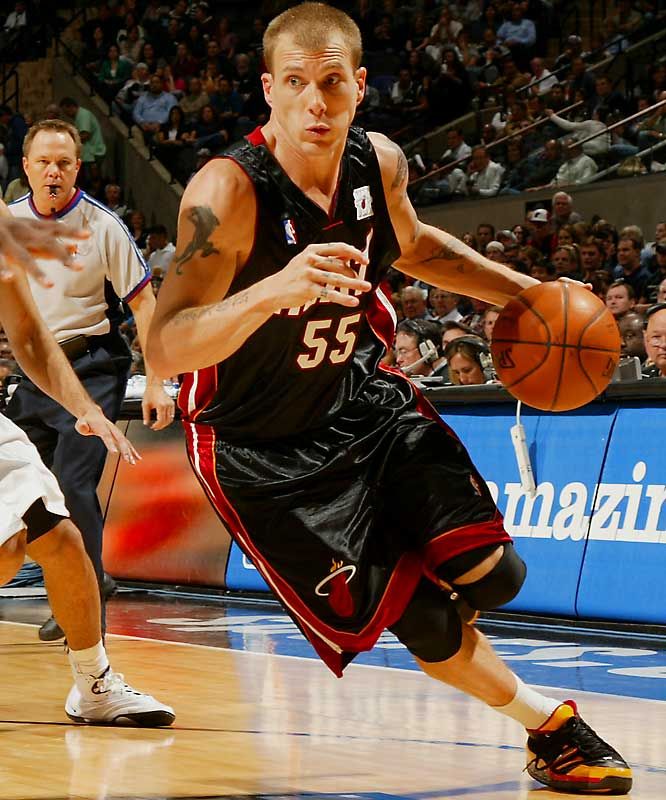
Offending team - The team in possession of the ball is the offending team.
Defensive team - The team that is not in possession of the ball and tries to control it is the defensive team.
Shot hours – Shot hours show the amount of time allowed for the attacking team to reach the target. If a team fails to make a goal, it is a tact violation and the ball is passed to the opposing team for a throw-in. The clock is usually set to 24 seconds in FIBA and NBA matches. The clock returns to the full limit when the ball touches the basket or passes through the basket. In some cases, after a foul, the shot clock is usually set to a lower number, 14 in NBA and FINA matches.
Key - Painted area 16 feet wide on professional basketball courts.
Basketball Pistol - This ball pistol shoots basketball back to the player. Used during training.
Dunk Shot - A player makes a dunk shot while jumping and pushing the ball through the basket.
Free Throw - When a player is awarded a free throw, he/she may attempt a goal from 15 feet without any obstruction from the opposing team. Free throws are also awarded to the opposing team when a player commits technical fouls.
Penalty situation - A team is in a penalty situation if it commits five fouls in one quarter. The penalty gives free throws to the opposing team after a foul.
Ball held. Sometimes a player is surrounded by too many opponents and cannot pass the ball to any of his teammates. He has a firm grip on the ball and sometimes even one of his opponents can hold the ball at the same time. To take control of the ball, one of them must grab it with force. This situation is called a held ball.
Ball bouncing - The referee may call for a ball to be thrown to deal with a ball holding situation and get the ball back into play. The referee also starts the game with a jump ball. A ball is thrown vertically into the air between two opponents.![]() Either of them pushes him towards a teammate.
Either of them pushes him towards a teammate.
Point Guard, Shooter, Small Forward, Power Forward, Center are the different positions of the team members. They are not required to occupy a specific position, and the team may refuse command positions. It is sometimes used to get attention and please viewers.
The ball is tossed into the air to start the game. One of the players diverts it to a teammate. He dribbles and passes among teammates to protect the ball and score a goal. The basket or hoop is placed horizontally at a height of 10 feet on the back board. Each team tries to protect the target on their side by trying to make the target on the opponent's side.
The opposing team tries to get the ball, take control of it by bouncing and try to grab it when it is passed among teammates to prevent the goal. When a player commits a foul, the other team gets a free throw or ball chance. Each goal is worth two points, and each free throw is worth one point.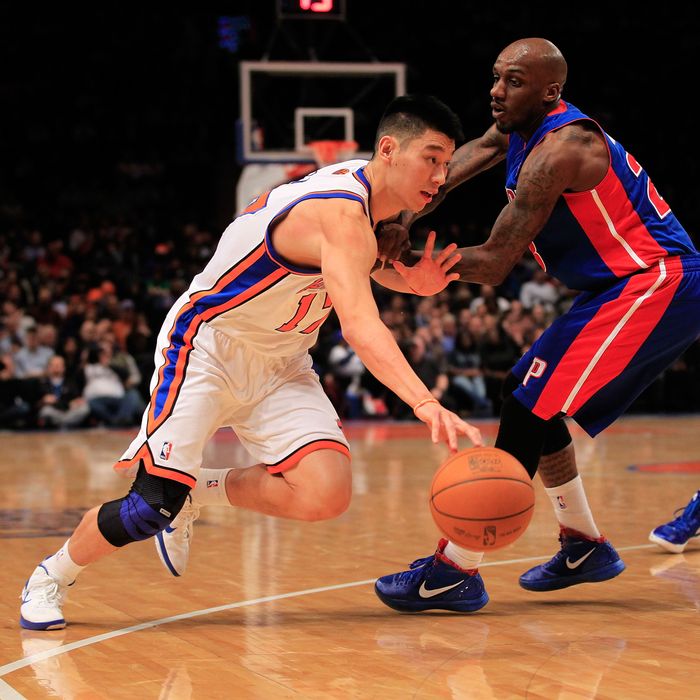 The team with the higher score wins the game. Players may be substituted when a substitute requests.
The team with the higher score wins the game. Players may be substituted when a substitute requests.
The game starts when the referee throws the jump ball. In international sports, each game is divided into four 10-minute periods. However, if there is a tie between the teams, they play for an extra period of 5 minutes.
After the first period and after the third period, the players take a 2-minute break. After the second period, the players take a 15-minute break and exchange baskets. After the break, the last player holding the ball scores the ball and the next period begins.
The game time may also be extended if the foul is committed shortly before the time. In such cases, a free throw is awarded regardless of the time interval.
If a player shoots the ball before the time expires, but the ball flies down the basket after the timer expires, the goal is still counted.
Rules of the game
Although basketball was invented with thirteen rules, some rules have been changed and many rules have been added to help players play faster and make the game more interesting for spectators.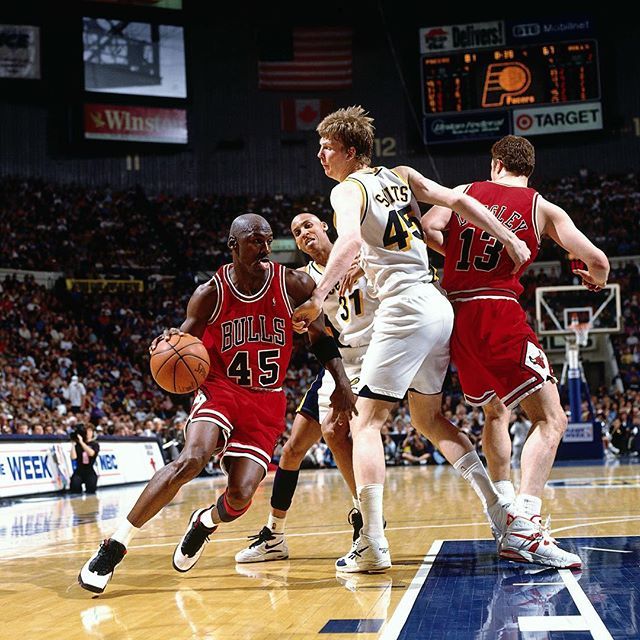 Some rules have been introduced to minimize the height advantage that taller players have.
Some rules have been introduced to minimize the height advantage that taller players have.
There are many variations of the game in different locations, and these branches have governing bodies that formulate the rules of the game. In the US, basketball tournaments are very popular in colleges. Their rules in intercollegiate championships are slightly different from professional basketball.
-
Any player in possession of the ball may not remain inside the dirty ring of the court with their back to the basket for more than three seconds.
-
No player must touch the ball, basket or rim while the ball is passing through the basket.
-
Players are allowed to make short contact with an opposing player who is trying to pass the ball or score a goal, but they may not interfere with him.
-
Players making more than five fouls are removed from the game.
-
Fouls appropriate to the situation, free throws to the opposing team and the ball is passed to them.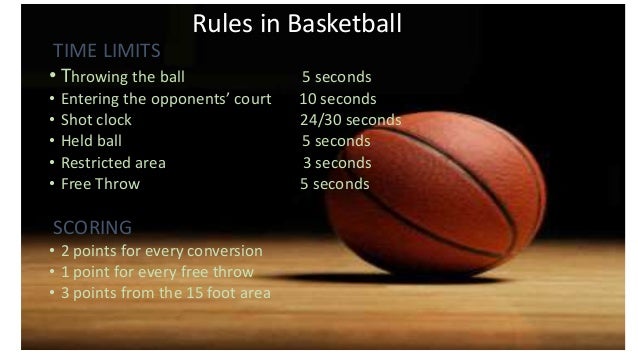
-
Players may not carry the ball and walk or run. It's called travel
-
When a player is surrounded by opponents within one meter while trying to hold the ball, he/she cannot hold the ball for more than five seconds. Such a player is considered to be closely guarded.
-
Players of the team in possession of the ball must not remain in the opposing team's restricted area for more than three seconds.
-
They must shoot the ball before the clock ticks.
Any player in possession of the ball may not remain inside a dirty ring with their back to the basket for more than three seconds.
No player must touch the ball, basket or rim while the ball is passing through the basket.
Players are allowed to make short contact with an opposing player who is trying to pass the ball or score a goal, but they may not interfere with him.
Players making more than five fouls are ejected from the game.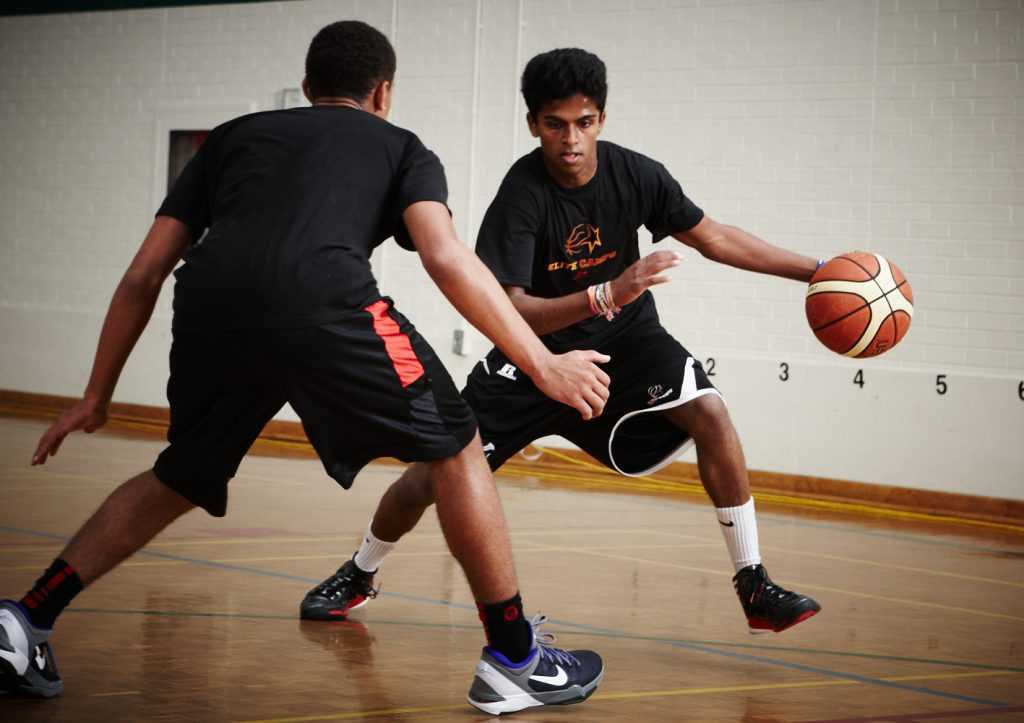
Fouls appropriate to the situation, free throws to the opposing team and the ball is passed to them.
Players may not carry the ball and may not walk or run. It's called travel
When a player is surrounded by opponents within one meter while trying to hold the ball, he/she cannot hold the ball for more than five seconds. Such a player is considered to be closely guarded.
Players of the team in possession of the ball must not remain in the opposing team's restricted area for more than three seconds.
They must shoot the ball before the clock ticks.
What should a basketball player not do?
The player must not -
-
Throw the ball out of bounds.
-
Step along the foul line by freely throwing the ball.
-
Step at the end or touchline while passing the ball to a teammate.
-
Kick the ball.
-
Drip or punch the ball.
-
Double ball dribbling.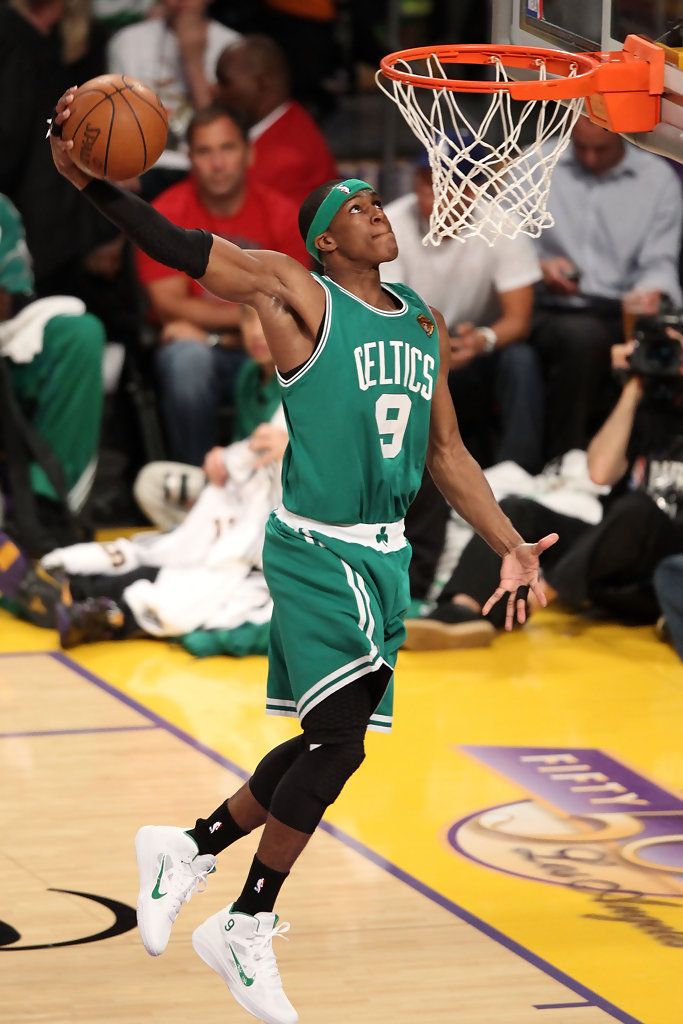
-
Hold the ball and stay in the backcourt where their basket is for more than 8 seconds or the team in charge shall be in breach of the rules.
Throw the ball out of bounds.
Step along the foul line while freely throwing the ball.
Step at the end or touchline while passing the ball to a teammate.
Kick the ball.
Drip or punch the ball.
Double ball dribbling.
Hold the ball and stay in the backcourt where their basket is for more than 8 seconds or the team in charge must foul.
If a team or player violates any of the rules mentioned above, the team loses the ball and the ball is awarded to the opposing team. The opposing team throws him from the side of the court, this is called a throw-in.
The rules for women have been slightly changed to reduce the burden on the players. Clara Baer, who introduced basketball for women, published a set of rules for women players in 1895.
Regulators
FIBA - The International Basketball Amateur Federation (FIBA) is the international governing body for basketball.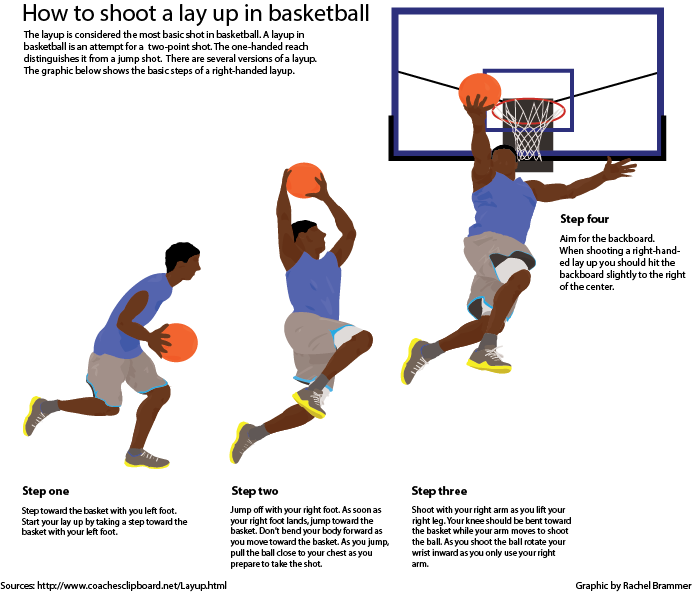 It regulates the rules, appoints referees for international tournaments, and hosts the World Championships every four years for both men and women. He is based in Geneva.
It regulates the rules, appoints referees for international tournaments, and hosts the World Championships every four years for both men and women. He is based in Geneva.
NBA - No basketball textbook would be complete without mentioning the NBA, the most important basketball league based in North America. The NBA organizes league championships and is a member of the US Basketball Association. Its players are highly paid and also play for other teams outside of the US. Attracted by huge talent in the US and high rewards, many international players also play in the NBA league. The NBA formulates rules for its matches, which may differ slightly from those set by FIBA.
There are many variants of basketball that are usually played when there are fewer players, sometimes in half the field and mostly without a referee. These games are commonly known as basketball games.
3 vs. 3 or 3 on 3
This is a popular game usually played in the half court when six players are gathered on the court and waiting for other players to appear.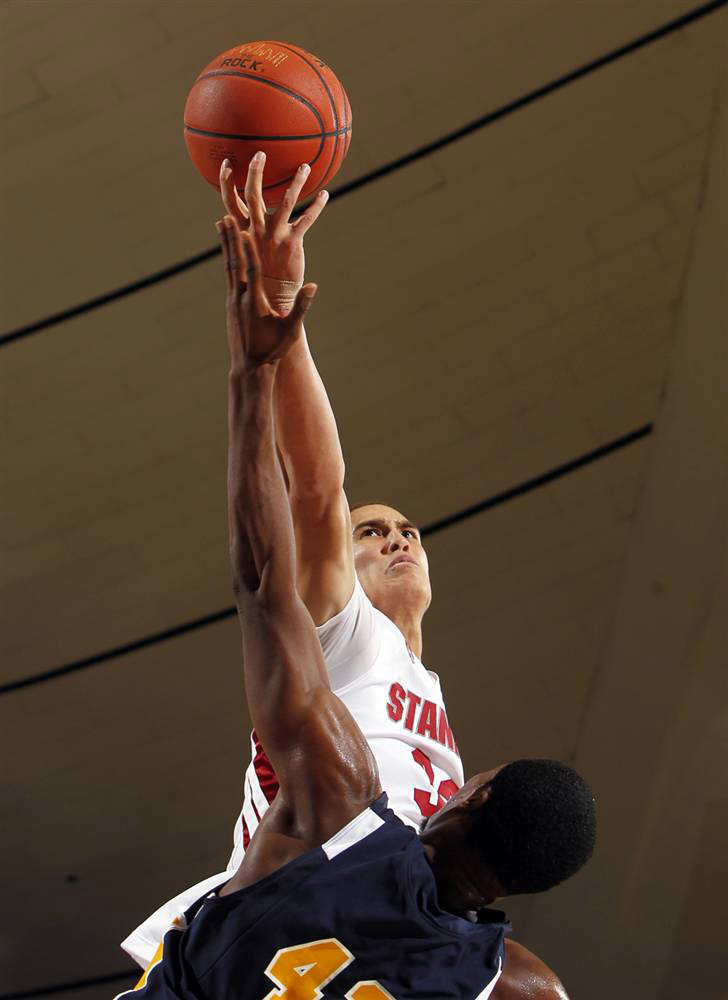 This game continues until one of the teams reaches a set score, usually 12 or 21. This game can be played with any even number of players. The rules of the game are basically similar to the official sport, but the team that catches the bounce must hit the ball off the three-point line.
This game continues until one of the teams reaches a set score, usually 12 or 21. This game can be played with any even number of players. The rules of the game are basically similar to the official sport, but the team that catches the bounce must hit the ball off the three-point line.
21 or cut throat
This is a separate sport that can be played by any number of players. The first player to score exactly 21 points wins the game. A goal carries 2 or 3 points and is usually followed by a one-point charity free throw or a two-point charity free throw from a three-point line. A successful charity shot may be followed by another until the player reaches 21 points. But if the player scores 22 points, the score goes back to 13 or 15 points. The game is less restrictive and more interesting as there are no fouls.
Chicago
This game is similar to 21, but the main difference is that the players take turns and stay off the court. For example, when three players are playing a game, if the first scores a goal, the second leaves the court and the third starts to play, and if the third scores, then the first must leave the court for the second and third player.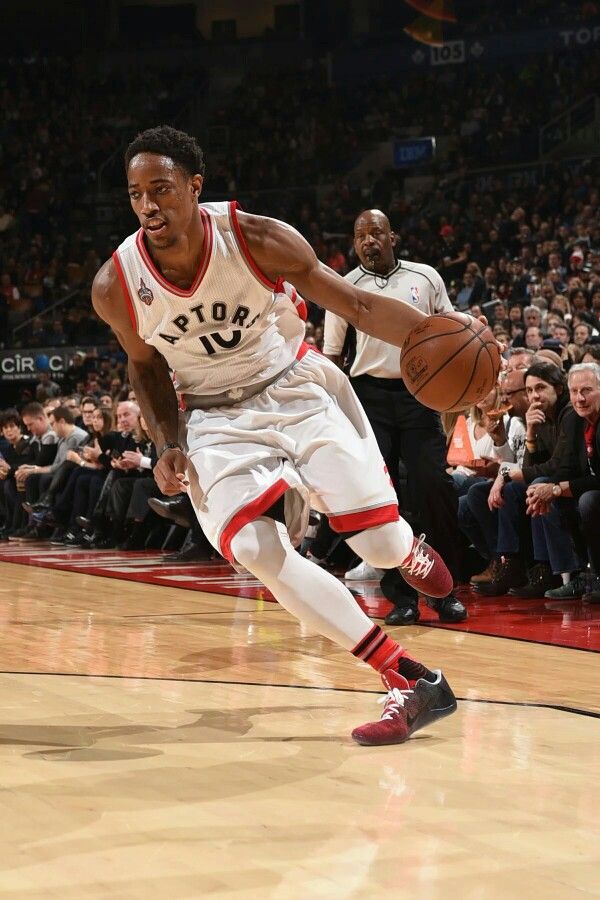
horse
This is an interesting game in which two players challenge each other's ability to shoot and the shots are not protected. Each alphabet of the word "HORSE" is used to award a negative score.
The player challenges the next player by shooting the ball from any spot he chooses, and if he sets a goal, the next player must score from the same spot, otherwise he gets a negative 'H' mark, and the first player gets the chance to shoot again new challenge again. However, if the first player to challenge the other misses the goal, the next player gets a chance to score from anywhere on the court and challenges the first.
If the challenge is passed, the player who accepted the challenge gets the chance to score from any preferred spot on the court. The player who starts the game first and has five negative points on him is called the "Horse" and is the loser.
Shooting competitions
There are various forms of shooting competitions, both on and off the line.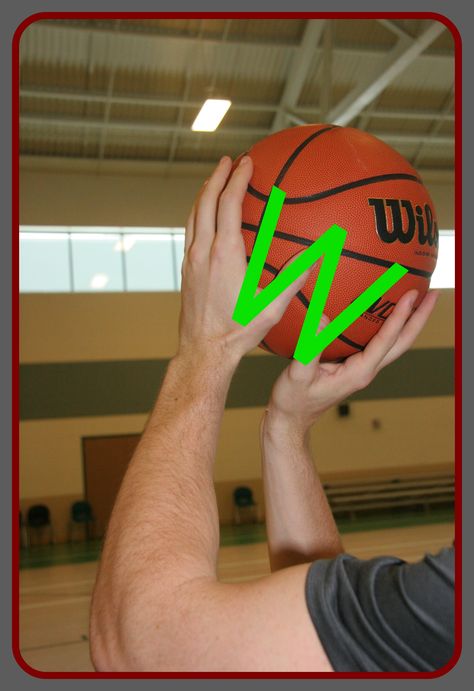 Players can choose the rules, whether shots can be protected or unprotected. There is a three-point semi-circle defense shooting competition, called around the world or around the key, where players move from one end of the circle to the other when they successfully set targets. When a player concedes a goal, the next player gets a chance. Sometimes the players have to start over every chance, and sometimes the players agree to mark the place where they made the last successful goal.
Players can choose the rules, whether shots can be protected or unprotected. There is a three-point semi-circle defense shooting competition, called around the world or around the key, where players move from one end of the circle to the other when they successfully set targets. When a player concedes a goal, the next player gets a chance. Sometimes the players have to start over every chance, and sometimes the players agree to mark the place where they made the last successful goal.
Slam Ball
The kicking area has four trampolines located under the basket and the players must jump the ball and dunk. Scoring rules may be slightly different.
Basketball - Tournaments
Coach Forrest S. (Fog) Allen led the movement to include basketball in the Olympics in 1936. Basketball is widely used all over the world. About 215 different national basketball organizations are members of FIBA. Many of these federations organize basketball championships and the winners take part in international competitions.
Some of the popular international championships are listed below -
- FIBA World Championship
- FIBA Women's World Championship
- NCAA Women's Championship
- NCAA Men's Championship
- WNBA Championship
- NBA Championship
- FIBA Asian Championship
* NCAA - National Collegiate Athletic Association
* WNBA - Women's National Basketball Association
Most champions and championships have funny and witty nicknames. Not only do they add a fun element, but they are an important part of the game and get a lot of media attention.
Many teams have won basketball games in the Olympics, but due to the popularity of NBA games and championships, very few non-NBA players are as popular as NBA players. It has become the norm for any champion of any country to join the NBA and play in their championships.
Some of the famous basketball champions are listed below.
Bob Cousy
Bob Cousy, nicknamed "The Hardwood Houdini," is an American professional basketball player and is considered one of the world's greatest ball guards.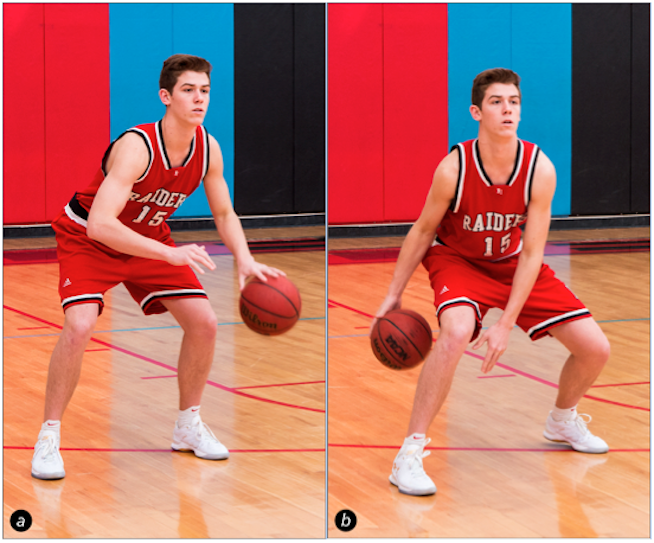 He was a member of the American professional basketball team from Boston, the Boston Celtics from 1950-1963. He also coached at Boston College from 1963–69.
He was a member of the American professional basketball team from Boston, the Boston Celtics from 1950-1963. He also coached at Boston College from 1963–69.
Bill Russell
He helped the United States win gold at the Olympics 1956 years in Melbourne. He also played for the Boston Celtics and is the first African-American basketball icon. The period in which he played NBA championships, from 1957 to 1969, is commonly referred to as the "Russell era".
Wilt Chamberlain
He was a strong opponent of Bill Russell and a student of Fog Allen's trainer, Chamberlain. In the 60s, he was a goal-scoring machine, and he was never fouled in any NBA game he played. He loved his nickname "Big Dipper" and was also affectionately referred to as "Wilt Stilt", "The Goalkeeper".
Magic Johnson
Ervin Johnson. Jr., better known as Magic Johnson, is an American basketball player. He was a member of the Los Angeles Lakers and led the team to five NBA championships.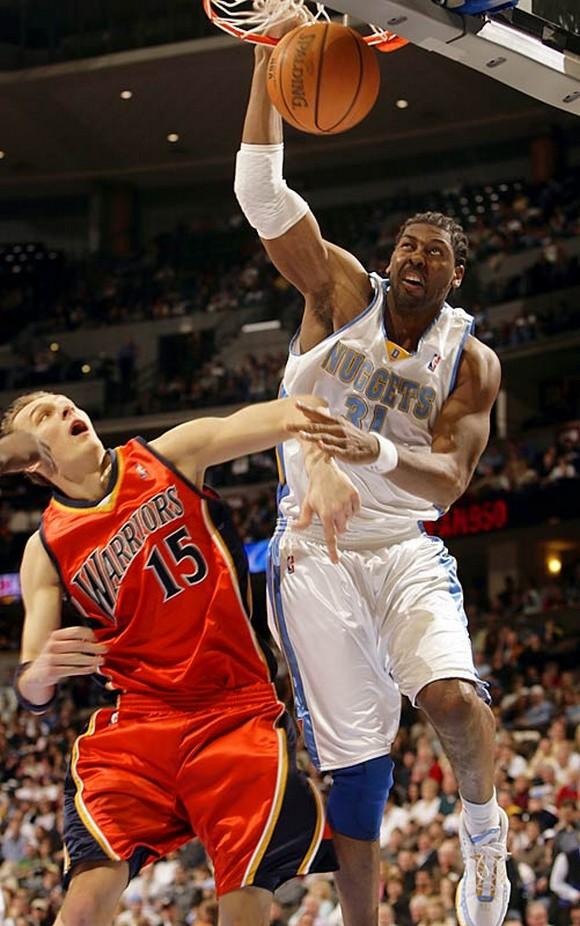 He is also used to entertaining spectators with his creative ball handling techniques.
He is also used to entertaining spectators with his creative ball handling techniques.
Larry Bird
Bird, known as the "Hick from French Lick", played 13 seasons with the NBA Boston Celtics and is an accomplished shooter. He was a member of the US men's basketball team, the Dream Team, which won the Barcelona Olympic gold at 1992 year.
Michael Jordan
Michael Jordan, nicknamed Air Jordan, is known for his exceptional acrobatic ability to jump higher. He was widely regarded as the best basketball player of all time. He is good at shooting, passing and also defending the ball. He helped the US Olympic team win gold medals in Barcelona and Spain in 1984 and 1992.
Kareem Abdul-Jabbar
Kareem Abdul-Jabbar, born Ferdinand Lewis Alcindor. Jr. was the most popular American professional basketball player at 1970s and 80s. He was a member of the Milwaukee Bucks and Los Angeles Lakers in the NBA. He is also a popular actor and writer.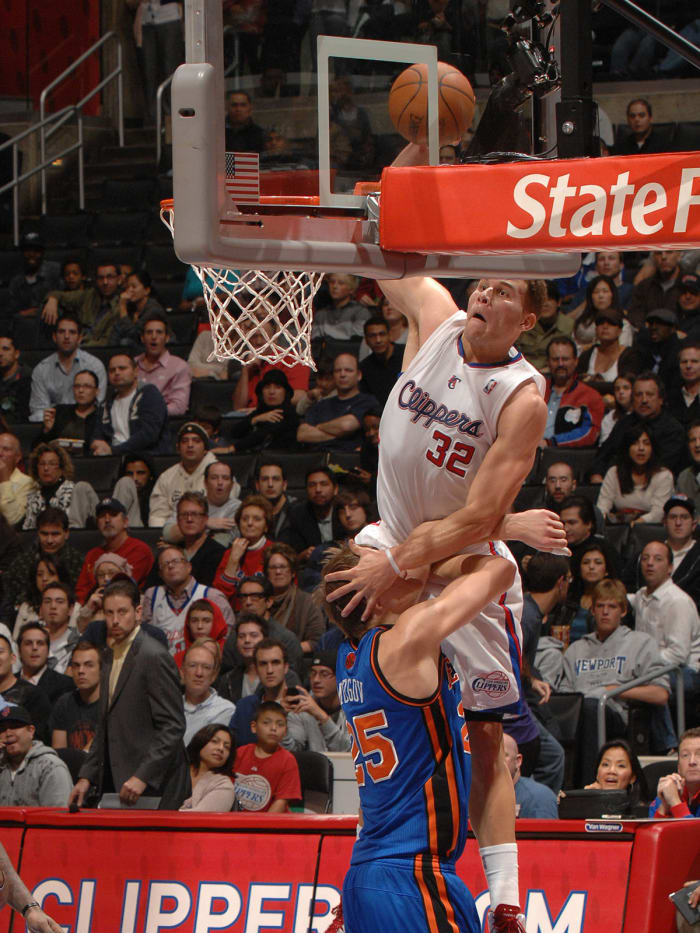
Shaquille O'Neal
Shaquille O'Neal, commonly referred to as Shaq, played for various NBA teams, Orlando Magic, Houston Rockets, Los Angeles Lakers, Miami Heat, Phoenix Suns, Cleveland Cavaliers and Boston Celtics. He was part of the US basketball team that won gold at the 1996 Olympics.
John Stockton
John was part of the NBA Utah Jazz, and although he wasn't as tall as most of his team, he was so good with the ball and interceptions that he was considered the greatest point guard in NBA history. He was part of the US basketball team at the 1992 and 1996 Olympics and also won two gold medals.
LeBron James
James, known as King James, was named Mr. Ohio Basketball. He was part of the Miami Heat of the NBA during the 2012 and 2013 wins. This tall, muscular, and athletic champion is also known for earning multimillion-dollar endorsements before even starting his career with the NBA's Cleveland Cavaliers. He was also part of the US men's Olympic team that won bronze in 2004 and gold in 2008.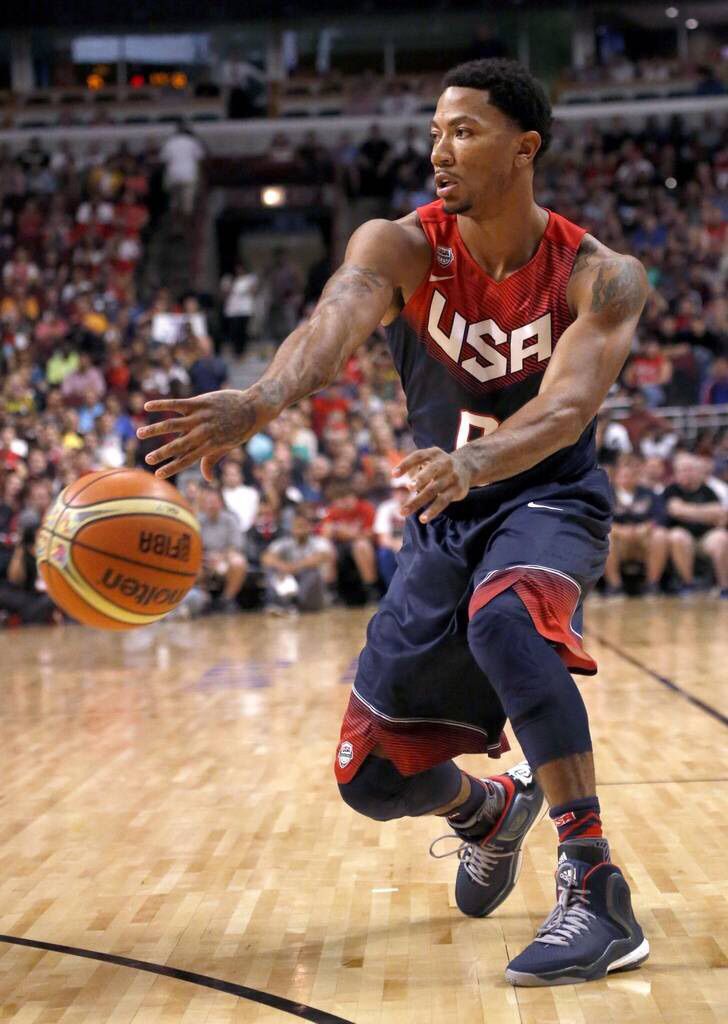
A. Ya. Gomelsky about strategy and tactics in basketball
copies of swiss watches
Strategy is the main theoretical direction of the entire work of the team, which determines the means and methods of preparation for the main competitions. Four-year plan for the preparation of the USSR national team for the Olympics in Seoul - the strategy of the team in 1985-1988. The strategy also provides for the management of the team during the competition.
Tactics is a part of the strategy that solves the main tasks of training, taking into account specific capabilities - team resources, characteristics of opponents, competition conditions. All this determines the tactical and combination baggage of the team.
When choosing game tactics (attack), one should proceed, firstly, from the real capabilities of the players, taking into account, first of all, their strengths, for the disclosure of which combinations are built and learned.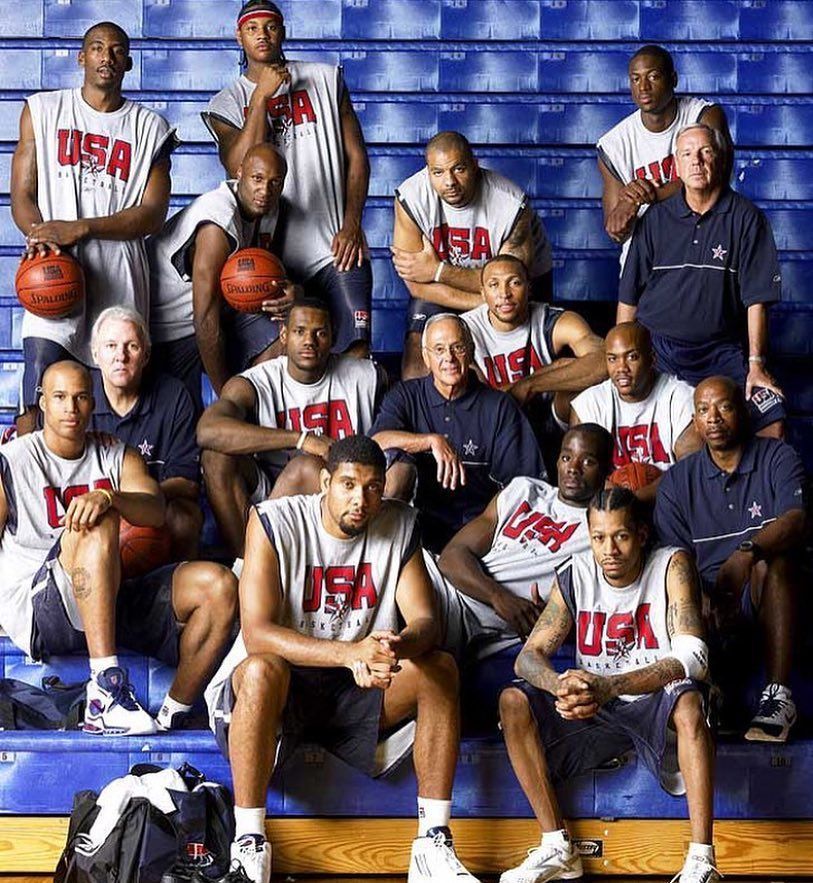 Secondly, attack tactics are determined by the strength and weakness of a real opponent in a tournament, match.
Secondly, attack tactics are determined by the strength and weakness of a real opponent in a tournament, match.
I usually discuss playing combinations with the players for whom this combination is designed. I know the strengths of my players, but the players themselves know them even better and can make significant adjustments to the combinations I have proposed.
A.Ya. Gomelsky about playing defense
I believe that defense is the main concern of the coach: firstly, because the victory of the team largely depends on its strength, secondly, because the attack starts from the defense, like from the stove, in- thirdly, because the players themselves never work on the elements of protection, and finally, because the audience, as a rule, does not see it, even journalists often underestimate it.
The best team cannot win without a solid defense. Team defense is built on the individual characteristics, capabilities and mood of all players. Often in training, and even in competitions, individual players show indifference to defensive actions. It always bothered me and even angered me. Yes, the menial work on defense isn't that spectacular - except for things like block shots, rebounds, interceptions.' And many players are not aggressive on defense, they are resting on defense, trying to prove themselves in attack.
Often in training, and even in competitions, individual players show indifference to defensive actions. It always bothered me and even angered me. Yes, the menial work on defense isn't that spectacular - except for things like block shots, rebounds, interceptions.' And many players are not aggressive on defense, they are resting on defense, trying to prove themselves in attack.
I am sure that without great desire, responsibility, initiative, passion, it is simply impossible to defend today.
If the defender allowed the attacker to receive the ball in the danger zone, he has already lost. And how many cases when the center is allowed to receive the ball in the three-second zone under the shield, without striving to actively fight for an advantageous position.
Often defensive players are in no hurry, they do not concentrate their attention and efforts enough on this part of the game.
I want to emphasize that the psychology of defense is one of the most important concerns of a coach, and often more depends on the focus on defense than on technique and physical condition.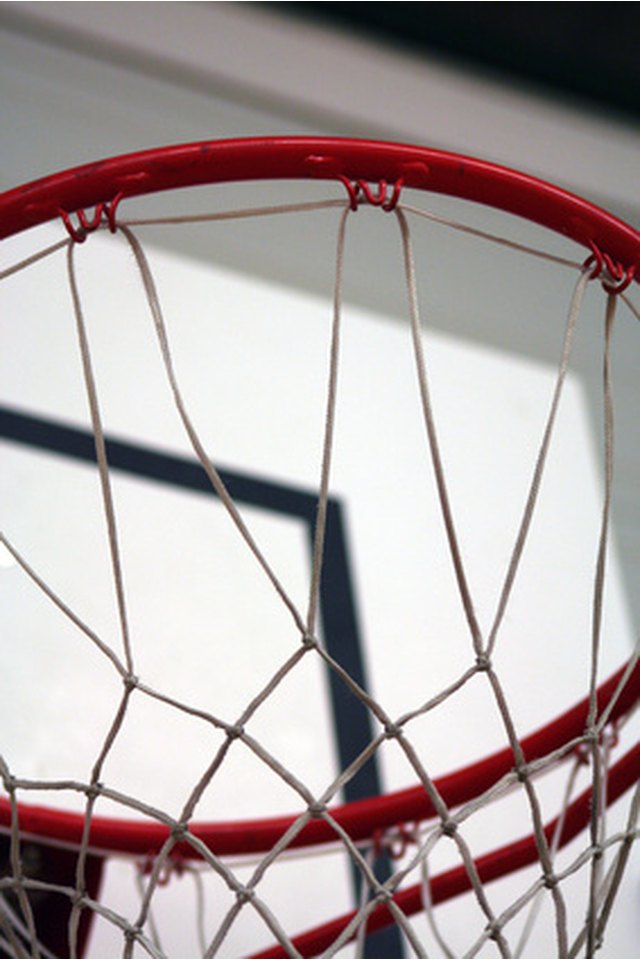 Doesn't the ability to intercept the ball and win the rebound depend on the mind and the ability to calculate one's strength? If a player goes to intercept the ball, exposing his rear, and slips past the ball, is this not the result of poor calculation, inability to predict, anticipate the situation, think and act responsibly? All this is the psychology of protection.
Doesn't the ability to intercept the ball and win the rebound depend on the mind and the ability to calculate one's strength? If a player goes to intercept the ball, exposing his rear, and slips past the ball, is this not the result of poor calculation, inability to predict, anticipate the situation, think and act responsibly? All this is the psychology of protection.
I believe that a player who is weak and inept in defense causes more damage to the team than a player who is weak in attack. The definition of "good defense is head and legs", while still valid, is incomplete. Fast, tenacious, active hands that can both hit and intercept the ball, and prevent a throw, pass, kick the ball while dribbling are no less important for a defender
Counterattack
Counterattack is the most spectacular and quick use of all opportunities to achieve result.
Fast play requires high technique. The desire to play at high speeds is commendable and acceptable only if the speed does not exceed the state of the art.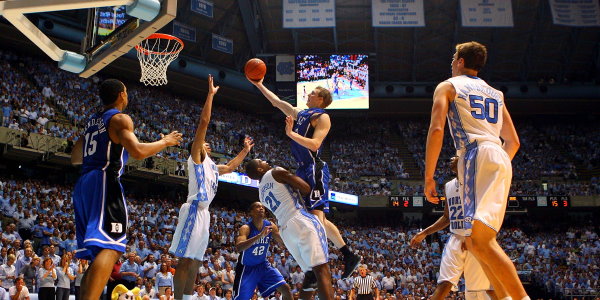 Otherwise, there will be more mistakes, losses of the ball than achievements. Therefore, in an effort to prepare a fast break, it is necessary to train the execution of all technical elements at high speeds, using both active and passive resistance of defenders in situations 1-1, 2-1, 3-2, 4-3, 5--4 and with numerical equality.
Otherwise, there will be more mistakes, losses of the ball than achievements. Therefore, in an effort to prepare a fast break, it is necessary to train the execution of all technical elements at high speeds, using both active and passive resistance of defenders in situations 1-1, 2-1, 3-2, 4-3, 5--4 and with numerical equality.
My idea of a counter-attack is not only to move quickly towards the opponent's backboard, but also to quickly transfer the ball to the opponent's backboard with sharp passes, or, if there is no free recipient to receive the ball, by dribbling the ball, actively moving forward. In the final stage of the fast break, players strive to create a triangle in the front line of attack with the apex on the free throw line. There should be a player with the ball, and two other players - to the left and right of him, 4-5 m ahead.
A counterattack is possible in the following situations:
1) when intercepting the ball;
2) when taking a rebound on his shield;
3) after the opponent has made free throws;
4) after winning a dropped ball;
5) after the opponent manages to score the ball.
The best outcome of a fast break is taking the opponent's ring with a numerical advantage, when implementing situations in numerical equality: 1-1, 2-2, 3-3, 4-4. This is easier than beating a 5-5 defense that has already built up its defensive formations.
There are three phases in a counterattack that are equally important for success:
1) the beginning of a fast break - picking up the ball, first pass, movement of the players, their start;
2) the middle stage of the development of the attack - the transition by the players of the middle line of the field, their advancement;
3) completion of the attack - passing the ball at speed and throwing in close proximity to the backboard.
The timing of the "rehearsed fast break" depends on the speed of the players, the ball passes and the finishing shot. The USSR national team spent 5-7 s on a layered fast break. I think that the schemes of her tactical formations will provide great opportunities for the creativity of coaches working with any teams.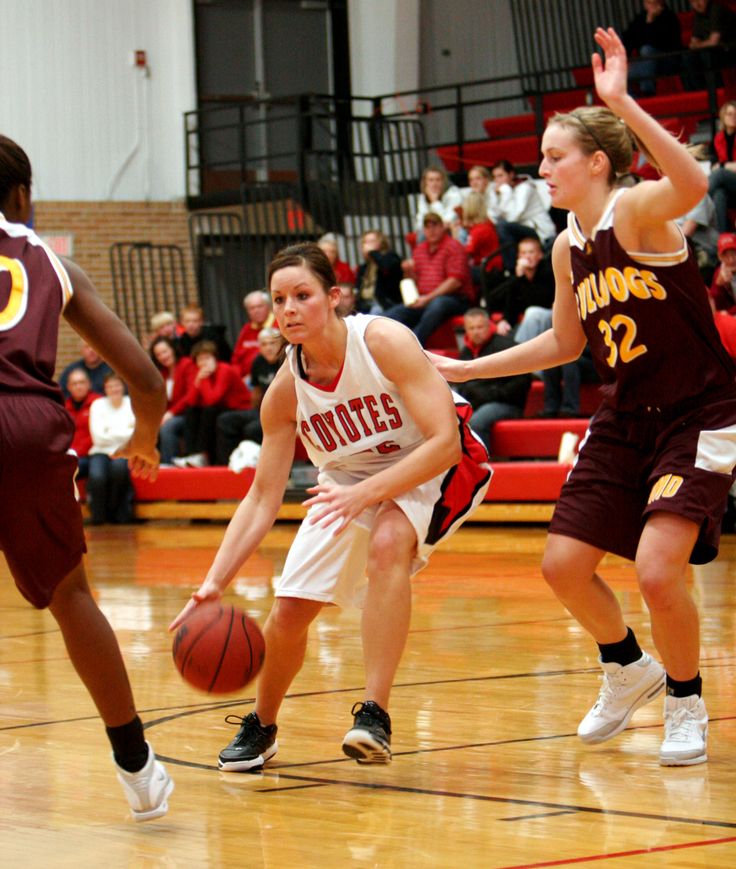
Playing in the USSR national team such powerful and tall centers as A. Sabonis and V. Tkachenko made it possible to carry out a counterattack due to one long pass across the entire court.
Center #5, after recovering the ball from the backboard, passes it to runaway #2.
Such an attack was especially successful when building a zone or mixed defense, when one of the defenders or wingers playing in the front line of defense was given the task of running away at the moment of throwing at our ring, in the expectation that the giants would be able to take possession of the ball , bouncing off the shield, and make a long pass across the entire field. Naturally, such a system of counterattack requires special coordination of actions, and its development takes considerable time in the training process.
Development of a quick counter-attack through the middle of the field.
Players #5, #4, #3 are fighting for the ball and, having mastered it, they try to make the first pass to player #2, who passes the ball to player #1.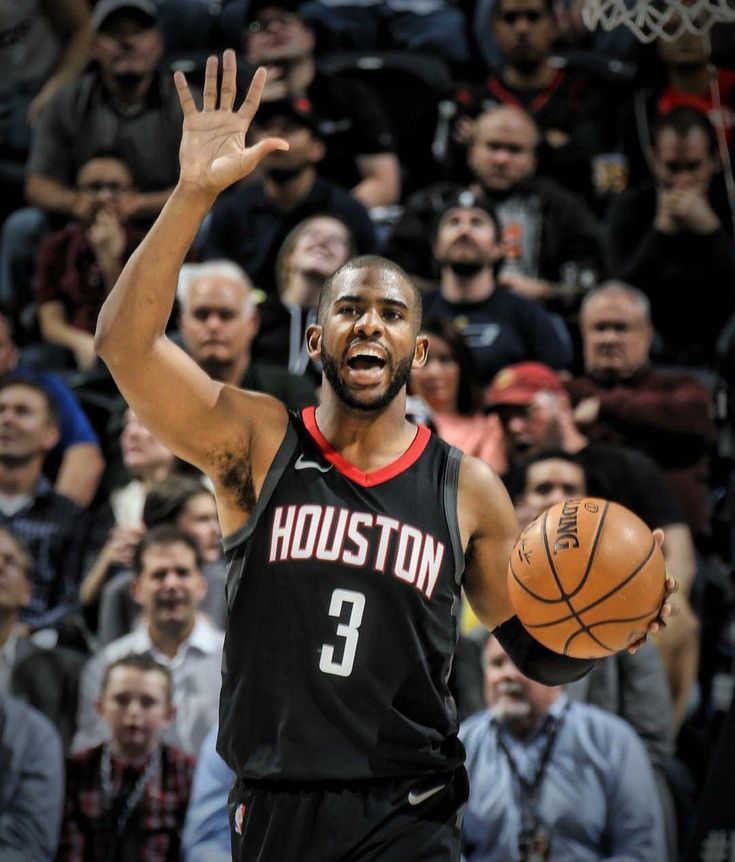 Player #1 rushes forward dribbling through the middle of the court. Players #2 and #3 overtake the dribbler at high speed, form a triangle with #1, and finish the attack with a close range throw if they manage to create a numerical advantage under the opponent's shield.
Player #1 rushes forward dribbling through the middle of the court. Players #2 and #3 overtake the dribbler at high speed, form a triangle with #1, and finish the attack with a close range throw if they manage to create a numerical advantage under the opponent's shield.
If it was not possible to complete the attack in the first echelon, then the second echelon - center players #4 and #5 - takes over. They, each on their own side of the court, rush to the opponent's shield. The one on whose side the ball is on ends the attack.
Development of a fast sideline break.
On a rebound from the left side of the backboard, the post makes a quick pass to player #2, who opens to receive the pass to the sideline, just above the free throw line. At the intersection of the sideline with the center, player #1 receives a pass from player #2, then passes it to player #4, who rushes forward on the left side. Player #4 has three possible continuations of the attack: give the ball to player #5 or #3, who is running towards the opponent's backboard in a straight line, or pass to player #2 in the area of the arc. It is clear that the transfer should be made to the most open player, who is in the most advantageous situation.
It is clear that the transfer should be made to the most open player, who is in the most advantageous situation.
A similar situation occurs when attacking on the opposite side.
Development of a fast break after a free throw into our ring.
If player #4 catches a bounce or quickly clears a potted ball from behind the endline, the first pass is to the left sideline to player #1 opening at or slightly above the free throw line. Player #2 opens near the center circle, receives the ball and dribbles forward. Players #5 and #3 pass the dribbler along the touchlines, player #4 overtakes him from the right, and player #2 stays slightly back in the backing position. Thus, player #2 has four options to choose the direction of the attack.
Same procedure as above, but after rebounding a field goal or after the ball is thrown in from behind the end line.
Developing a fast break after a dropped ball in the center circle or on the free throw line in our half of the field.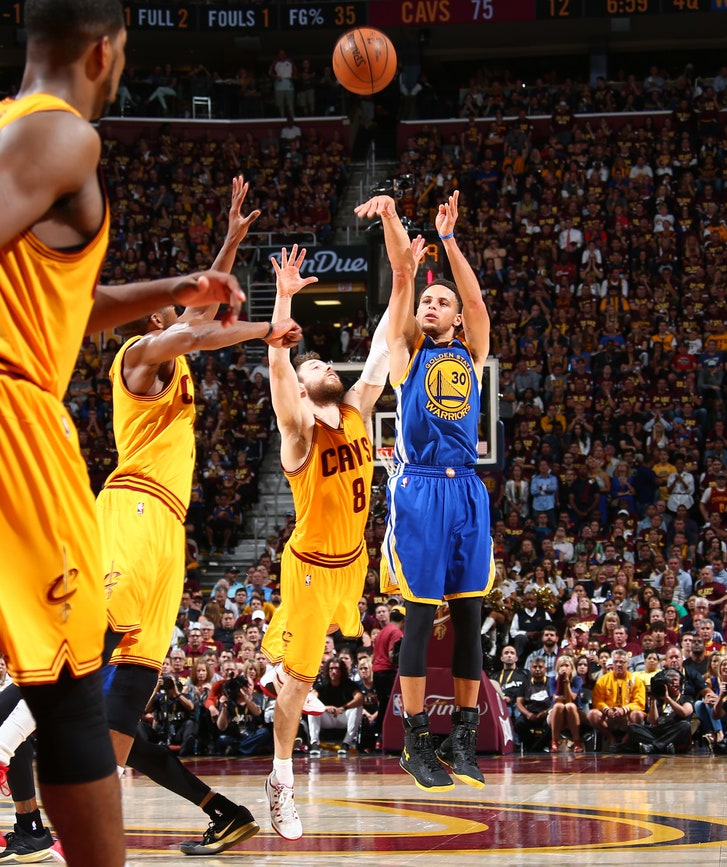
Player #5 discounts player #4 who is ready to receive the ball with his hands up. After catching the ball, #4 passes forward to player #1, who opens up to receive that pass after being screened by player #3. Players #2 and #4 support the attack. Such a combination can be played in both directions. At the heart of her success is high growth, good jumping ability and the ability to accurately throw the ball to the partner of the center player.
Same scheme, but now player #4 screens player #2 who, having received the ball from player #3, rushes forward.
The easiest way to complete a counterattack is for the players to take the shortest route to the opponent's backboard. However, with the development of a counterattack, options are possible with cross screens
interaction like a trio
setting screens for the second echelon players in the center of the field.
Many teams in the world, including the USSR national team, after failing to complete the counterattack with a scoring throw, in the transition to a positional attack, spent precious time placing players, thus allowing the enemy to prepare for defensive actions and occupy all the defenders advantageous positions.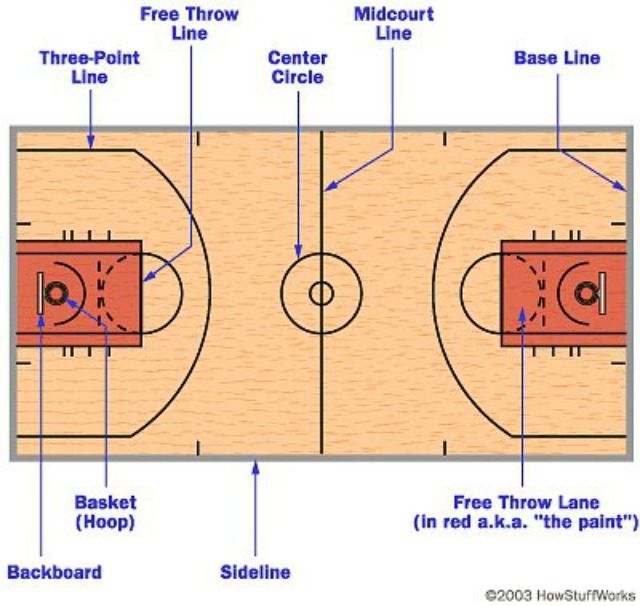 This is why a quick or non-stop attack after a counterattack ("transition game") is increasingly used in the tactics of the best teams in the world. I will give an example of such an attack in the USSR national team.
This is why a quick or non-stop attack after a counterattack ("transition game") is increasingly used in the tactics of the best teams in the world. I will give an example of such an attack in the USSR national team.
The fast break was not completed by the players of the first attack tier #2 and #3, nor the second tier #4 and #5. They, each on their own side, set up screens for fielders #3 and #2 for a shot from medium or long distance, and then go to the backboard to receive the ball in the three-second zone on the spot or to fight on the backboard, after a throw from one of the players # 2 or #3. Options for a non-stop attack can be very different. This could be a double or triple screen for the team's sniper, or a winger or post entering the 3-second zone after receiving the screen. It all depends on the characteristics and capabilities of the player for whom the combination is being made.
Double screen to Marciulionis (#2) to attack with his left hand from the free throw area.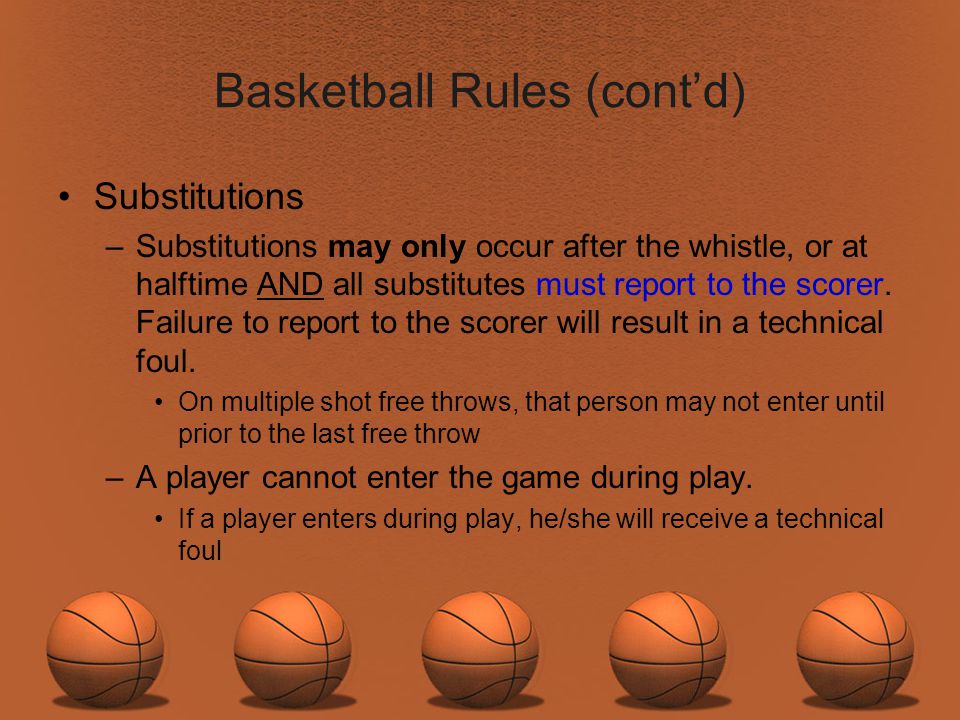
Players #4 (Volkov) and #3 (Tikhonenko) put up two screens for player #2 (Marciulenis) at the same time. #2 breaks into the free throw line, where he receives the ball from player #1 (Sokka). "Marciulionis has opportunities to continue the attack:
a) receiving the ball in motion and passing under the backboard;
b) receiving the ball with a stop and shooting on
c) passing the ball to player #5 (Sabonis) in case there is a switch of defenders.
Players #4 and #2 after screening go under the backboard to fight for the rebound.
Mixed defense
There are several mixed defense systems:
1. Four players build a zone defense 2-2
or 1-2-1
capabilities and tactics of the opponent.
2. Three players build a 2-1 zone defense and two guard the enemy's strongest snipers.
3. One player completes the zone formation and four players cover the opponents personally.
4. Two players form a zone defense and three players act as an individual defense.
Two players form a zone defense and three players act as an individual defense.
Mixed defense brought good luck to the USSR national team and the CSKA team more than once. The choice of defense has always been determined by the characteristics of the opponent and our capabilities.
In the final of the Olympic tournament in Seoul against the team of Yugoslavia, we used a mixed defense 1-4.
Sabonis played a zone defense, the rest of the players closely guarded their opponents. This was due to the presence of Vrankovic or Raja in the Yugoslav team, who are not very dangerous away from the shield, and the fact that Petrovich, Paspal, Kukoch posed a big threat. The players who guarded the leaders of the Yugoslav team could, with a greater degree of risk, fight with their opponents to get the ball. They knew that Sabonis would help them if they were beaten.
A similar defense was chosen in the semi-final tournament in Seoul against the US team. Sabonis did a zone defense and let Robinson or Reed or Maning shoot from wide. But the rest of the US players were completely covered, and a player like Maning did not bring a single point to the team. As a result, the USSR national team won 82:76. And Sabonis, who participated in the Olympics after a serious injury, two operations, took first place in the selection of balls from shields and made a great contribution to the victory of the USSR team.
Sabonis did a zone defense and let Robinson or Reed or Maning shoot from wide. But the rest of the US players were completely covered, and a player like Maning did not bring a single point to the team. As a result, the USSR national team won 82:76. And Sabonis, who participated in the Olympics after a serious injury, two operations, took first place in the selection of balls from shields and made a great contribution to the victory of the USSR team.
Sometimes, with two centers Sabonis - Tkachenko, we built a mixed, personally set defense 3-2. Two giants and one mobile defender played well in the zone. In the early 70s, it was Eremin, then Valters, and at the Olympics and the pre-Olympic tournament Sokk performed this function, and Belostenny and Volkov played instead of Sabonis and Tkachenko in Holland.
At the Seoul Olympics, we used such a defense (3 in the zone, 2 in person) against the Brazilian team.
Sabonis, Volkov and Sokk built a triangle, on top of which Sabonis and Volkov played. Tikhonenko took care of So-uzu personally, and Marciulionis took care of Schmidt, and although these two players scored 65 points together, the match turned out to be very difficult for us, but we still won 110:105. The mistake in the choice of defense was that Schmidt outplayed the smaller Marciulionis in different positions, and Souza outplayed the slower Tikhonenko. In the last 10 minutes of the match, Volkov was attached to Schmidt, Marciulionis switched to Souza, and we changed Tikhonenko to Goborov in zone defense.
Tikhonenko took care of So-uzu personally, and Marciulionis took care of Schmidt, and although these two players scored 65 points together, the match turned out to be very difficult for us, but we still won 110:105. The mistake in the choice of defense was that Schmidt outplayed the smaller Marciulionis in different positions, and Souza outplayed the slower Tikhonenko. In the last 10 minutes of the match, Volkov was attached to Schmidt, Marciulionis switched to Souza, and we changed Tikhonenko to Goborov in zone defense.
Benefits of mixed defense
allows you to fight with him to get the ball, while expecting the active help of teammates, without fear of a throw.
2. Such a system, if the opponent is not prepared for it, tactically introduces confusion and makes it difficult to carry out screening combinations.
3. Combines the best aspects of individual and zone protection systems.
4. Promotes a quick transition from defense to counterattack.
5. Gives players the opportunity to use their strengths in defense and not show weaknesses.
Gives players the opportunity to use their strengths in defense and not show weaknesses.
6. Can take the point guard out of the game and deprive the opponent of the usual formation and rhythm, destroy the counterattack if applied pressure throughout the field.
Weakness of the mixed defense
1. A technically competent team that has several leaders easily rebuilds the offense and breaks the mixed defense.
2. Simultaneous movements of two or three players diagonally can destroy a mixed defense if the opponent manages to create a numerical advantage on one of the sides of the field.
3. Often vulnerable to medium throws from 3-4m.
4. Requires special lengthy preparation, coordinated actions, high teamwork of the whole team for rebuilding and interchangeability in positions.
5. If one of the five players did not have time to reorganize or did not cope with his duties, then the whole idea of such a defense breaks down.
A.

Ya. Gomel. Pressing defense
Pressing is the most active type of defense, constant pressure on the opponent. It can be personal or zone, it can start from the moment the opponent throws it: all over the court, on 3/4 of it, in their own half, i.e. on 1/2 site.
The goal of defense by pressing is not only psychological pressure on the opponent, but also the desire to break the opponent's established game, break his habitual connections between defense and attack, his combinations, make inaccurate passes of the ball, hasty - throws. It is impossible to apply pressure without mastering enough methods of individual protection. This form of defense requires high physical condition, good reserve and teamwork of all players and team units.
Pressing is used both as a system of play for long periods of time, and as a forced measure: when losing in a score to increase the pace or when waiting for pressure from an opponent.
By pressing, we try to take the ball away from the opponent - we force him to make false passes that are easily intercepted.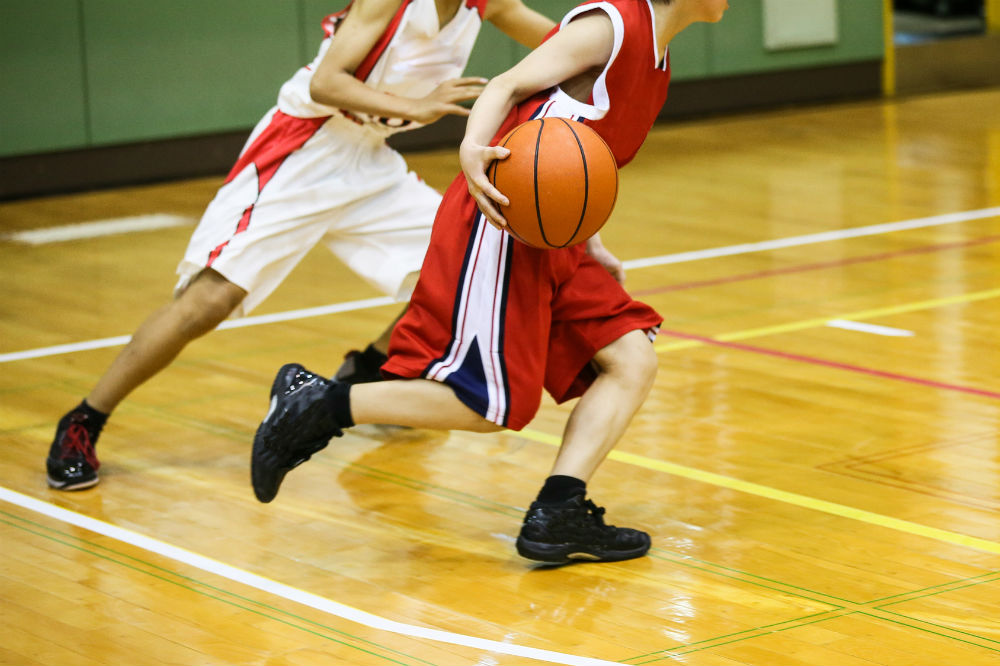 Often, the opponents of the front line of pressing, having missed the opponents, do not pursue them, but watch the development of further events - this is a gross mistake. It is necessary to chase the player with the ball, trying to knock the ball from him from behind, stepping on his heels. Thus, you force the opponent to rush, worry, make mistakes.
Often, the opponents of the front line of pressing, having missed the opponents, do not pursue them, but watch the development of further events - this is a gross mistake. It is necessary to chase the player with the ball, trying to knock the ball from him from behind, stepping on his heels. Thus, you force the opponent to rush, worry, make mistakes.
If in zone or personal pressing you are left without a player and do not help a friend, you make a miscalculation. If one of the five pressers is not active, the work of the entire team goes down the drain. Pressing is primarily an active defense of the team.
In modern basketball, many coaches tend to believe that personal pressing is less effective, difficult, leads to a large number of personal violations and is inferior in usefulness to zone pressing systems. I also believe that a strong, technical player with good dribbling is able to cope with personal pressure.
In addition, with a stretched defense, it would be incredibly difficult to keep one-on-one players such as Marciulionis, Volkov, Kurtinaitis, Petrovich, Schmidt, Kukach, Paspal, Rivier, Gallis. I'm not talking about NBA players. But although zone pressing has become more popular, it is impossible to do without the ability to play personal pressing. Therefore, it is necessary to train defense daily 1-1, 2-2, 3-3, 4-4 all over the court, with and without the ball, with and without dribbling, with and without screens, first at a walk, then at high speed.
I'm not talking about NBA players. But although zone pressing has become more popular, it is impossible to do without the ability to play personal pressing. Therefore, it is necessary to train defense daily 1-1, 2-2, 3-3, 4-4 all over the court, with and without the ball, with and without dribbling, with and without screens, first at a walk, then at high speed.
Exercises are useful in which the number of defenders prevails over the number of attackers. These exercises promote the interaction of the defenders, instill the skills of tackling the ball. They are also good for attacking players. When training personal pressing, due attention should be paid to the rapid movements of players in an active stance, in different directions, with a skillful change in the positions of players. Defenders of the first line of defense seek to push their attackers to the sidelines and prevent the attacker from getting around him with the ball and without the ball.
If one of the defenders managed to stop the attacker with the ball at the sideline at the intersection with the penalty or center line, the defensive partner must come to the aid of a friend: together they force him to make a cross pass, which the other three players are ready to intercept.
The initial stage of personal pressing is carried out by two fundamentally different tactical constructions:
1. The opponent who introduces the ball into the game holds a high moving edge and with an active movement of the hands prevents him from making an aimed pass.
2. No one guards the opponent who puts the ball into play, but two pressers prevent the most dangerous dribbler from getting the ball.
For example, Volkov secured Sokka and Marciulionis from behind when passing to player 5. make him stop and do not let him make an accurate pass, interfering with his hand movements;
2) if the defending partner allowed himself to be bypassed, immediately come to his aid, of course, without leaving your ward in a safe position under the shield;
3) constantly watch not only your ward, watch the actions of partners, learn to see the whole field.
In the national team of the USSR and CSKA, zone pressing 1-2-1 - 1 brought us the most success. We started pressing from the opponent's front line after a goal and a free kick. High extreme Volkov interfered with the throw-in. If the ball was injected to the right, Marciulionis and Volkov attacked X2 defender together, trying to prevent him from going forward and make an aimed pass to XI defender, Sokk followed the movement of X3 and X4. Sabonis secured the rear, was responsible for long passes and for the X5 player. Tikhonenko in the center of the field followed X4's pass with a long pass and went to the ball passing side.
We started pressing from the opponent's front line after a goal and a free kick. High extreme Volkov interfered with the throw-in. If the ball was injected to the right, Marciulionis and Volkov attacked X2 defender together, trying to prevent him from going forward and make an aimed pass to XI defender, Sokk followed the movement of X3 and X4. Sabonis secured the rear, was responsible for long passes and for the X5 player. Tikhonenko in the center of the field followed X4's pass with a long pass and went to the ball passing side.
Returning with a weak attack, we built a defense 2-3
Zone defense in basketball
The meaning of this defense is that the players are in charge of a certain area of the field, in accordance with the position of the ball and the formation of the attacking team.
Benefits of zone defense:
1. Allows players to be placed according to their physical, technical and mental characteristics.
Tall, jumpy players are positioned close to the backboard, agile, fast players are in positions higher from the backboard.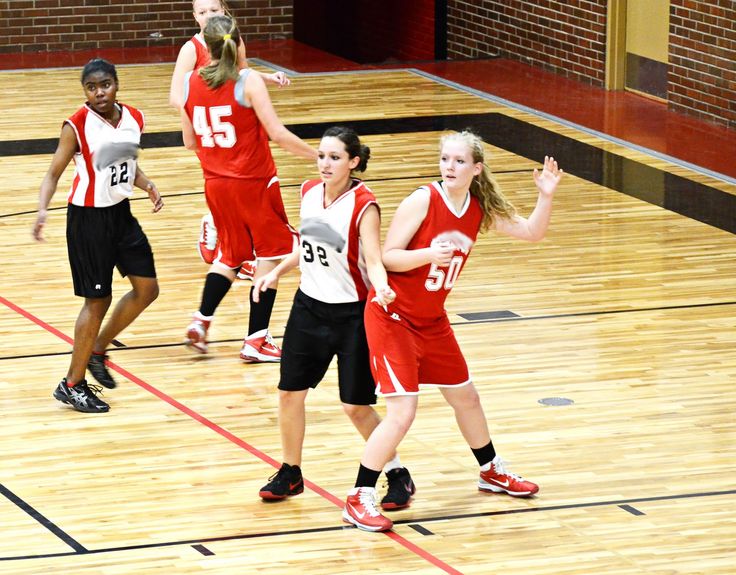
2. More team-oriented, easy to master, capable of compensating for individual players' gaps in defense.
3. Promotes counter-attacking and frequent interceptions of the ball with the greatest possible degree of risk, because. Partners are always ready to help.
4. The number of fouls in a zone defense is usually less than in a personal defense.
5. This defense is less vulnerable against screen combinations.
6. Can concentrate with strong opponent centers and stretch with snipers.
7. More than personal protection, it saves players' strength and protects leaders from fouls.
8. Most effective against opponents with strong centers.
9. A team that owns a zone defense can easily build mixed forms of defense: 3-2, 4-1, 2-3.
10. Convenient and suitable for small fields.
Disadvantages of zone defense:
1. Inferior to the personal psychological responsibility of the players, their charge for individual victory in defense.
2. Less useful against teams with strong snipers.
3. As a rule, the corners of the court are less protected in zone defense.
4. Zone defense may be used occasionally and should not be the main form of defense. It is not advisable to use zone defense at the beginning of the match, when the opponent's players are not yet tired, energetic enough - their throws are more accurate and productive than at the end of the game.
There are several formations of the zone defense, however, each of the zone defenses should easily transform depending on the attack - stretch when attacking from a distance and group around the ring.
Even type of zone defense formations includes systems: 2-2-1, 2-1-2, 2-3.
Odd formation: 1-2-2, 1-3-1, 3-2.
Each of these constructions has its advantages and disadvantages, which are useful to analyze.
The arrows indicate the direction of movement of the players. The shaded places on the court are the weak positions of the defense.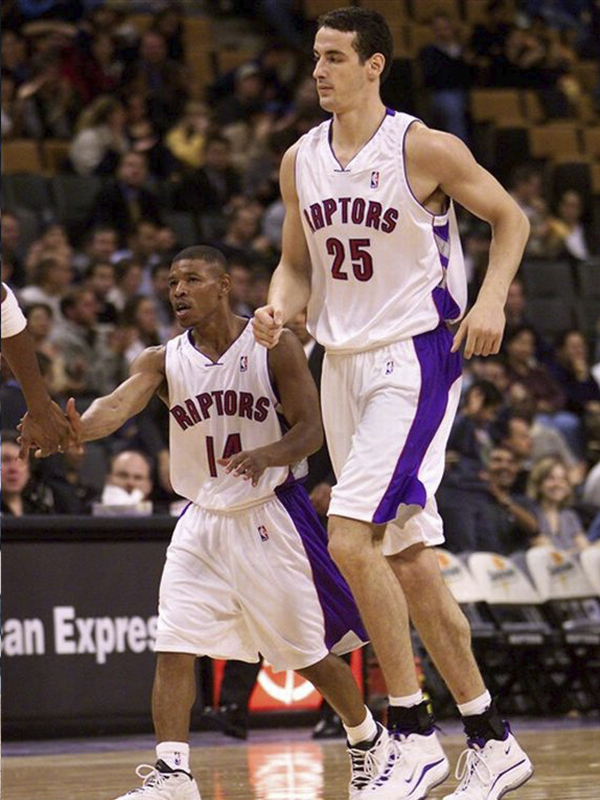
Zone defense 1-2-2
#1 - the lightest, fastest defender, #2 and #3 - quite mobile, jumpy, good if their height is at least 2 m. #4 and #5 - centers. Their task is to fight with the opponent's centers, picking up balls from the shield.
This system is most useful against teams trying to attack from under the shield through the post. Disadvantages - weak positions indicated in the figure.
Zone defense 2-1-2
It is used against strong opponent's centers who are dangerous on the "second floor" when rebounding the ball. Good for developing a counterattack with fast #1 and #2 players. Vulnerable in corners under 45, in the center for long and medium throws. The task of post #5 is to mark the opponents' post and, together with ?3 and ?4, create a rebounding triangle. #3 and #4 are mobile and high wingers, they can be swapped depending on the place of the sniper's attack.
Zone Defense 1-3-1
Helps to keep #3, #5, #2 between the ball and the basket at all times, used against opponent's strong centers and shots from middle and close positions.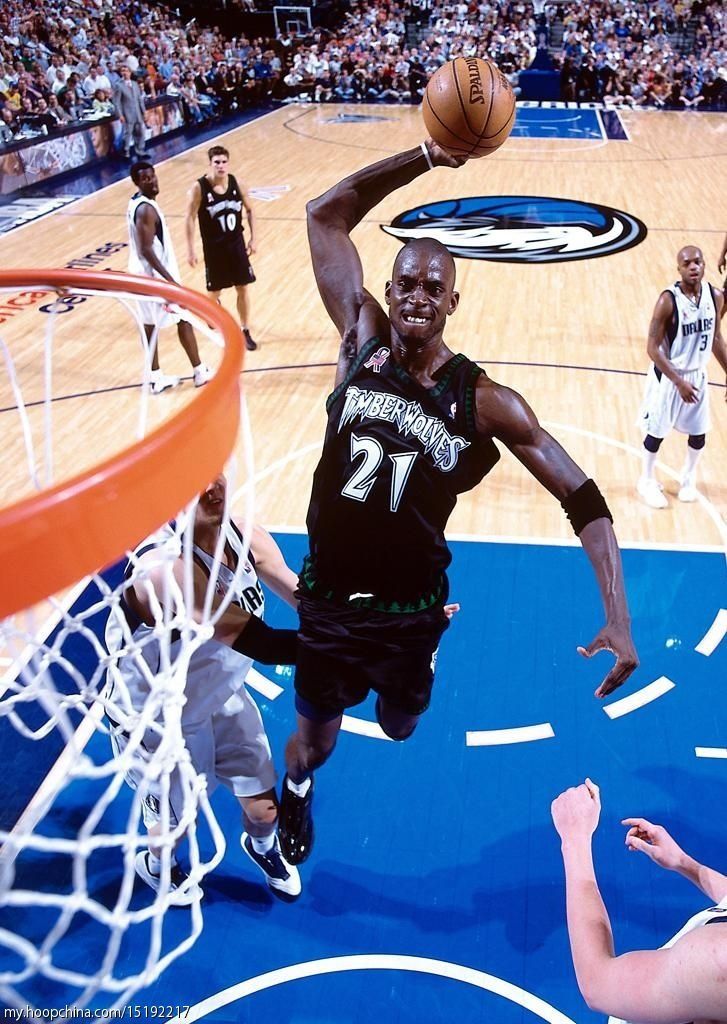 Her weakness is throws from the corners of the site and passes to the shield along the front line.
Her weakness is throws from the corners of the site and passes to the shield along the front line.
#1 - the fastest defender, running into the gap in every possible situation, #2 and #3 - mobile, jumping players, #5 - center, #4 - the fastest winger, able to move into the corners of the court.
Zone defense 3-2
#1, #2 and #3 are aggressive, mobile players, the success of the whole system largely depends on their activity. All three are focused on intercepting the ball and counterattacking. This system is most acceptable against teams seeking to attack from a distance, and less suitable against strong centers. The 3 second zone and 45 angle positions are the most vulnerable. #1 is in charge of the foul line. #2 and #3 are in a rebound fight. #5 and #4 are the first and second centers.
Zone protection 2-3
Strongest under the backboard, in the corners of the court along the front line. It is used against a tall, powerful team attacking from close positions and from under the shield.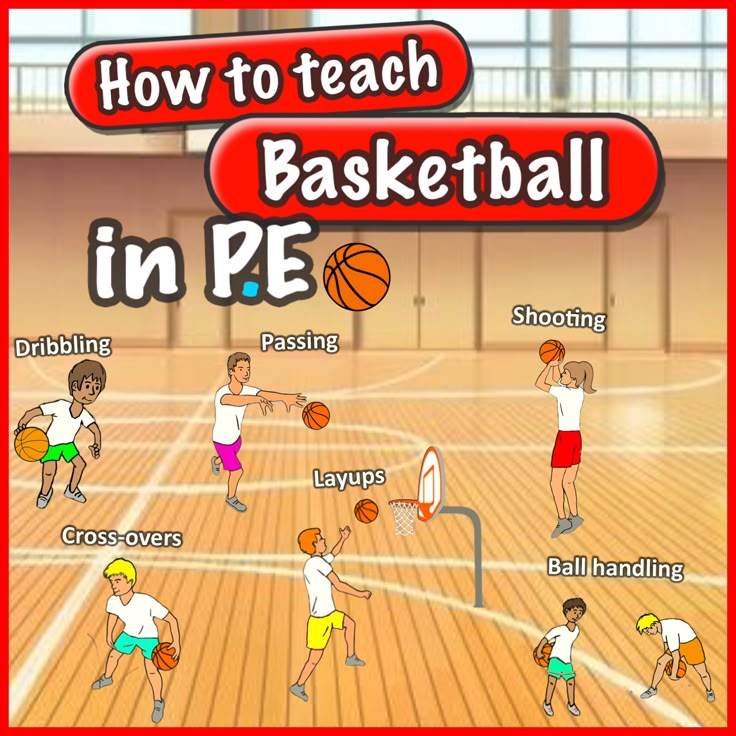 Often used for group selection of the ball in the corners of the court. When interacting #4 and #2 or #3 and #1, the defense is less effective on the foul line and at a 45 angle. #5 - center, #4 - second center, #3 - winger, #1 and #2 - defenders, constantly aimed at interception and counterattack.
Often used for group selection of the ball in the corners of the court. When interacting #4 and #2 or #3 and #1, the defense is less effective on the foul line and at a 45 angle. #5 - center, #4 - second center, #3 - winger, #1 and #2 - defenders, constantly aimed at interception and counterattack.
Zone protection 2-2-1
This defense is used by agile and short teams aiming to intercept the ball and constantly counterattack. This zone counterattack is used against teams seeking to attack from medium distances. Center #5 is responsible for rebounding, wingers #3 and #4 are responsible for positions in corners and under 45 , rebounding the ball and for the foul line.
Defenders #1 and #2 tend to close the passes to the shield and into the three-second zone, while they themselves are constantly aimed at counterattacking.
A.Ya. GomelskyDefense against ball carrier
It is necessary to work out the correct body position in a basketball stance: the center of gravity is evenly distributed on both legs, but not on a full foot, but on toes, with a "charged" (ready for any movement) foot, knees slightly bent, legs slightly wider than shoulders . Boxing stance - like the great Michael Jordan.
Boxing stance - like the great Michael Jordan.
If the opponent is in possession of the ball, one arm of the defender must be directed at the ball and constantly attack the opponent, preventing him from aiming or throwing (best if it touches the attacker), and the second arm slightly pulled back. Many defenders, being between the player with the ball and the basket, even in the correct stance, do not actively use their hands, do not make an offensive movement towards the attacker, which allows the opponent to calmly take further actions. At the same time, it must be remembered that you cannot cross your legs, that the distance between the defender and the opponent must be calculated so that the opponent can pass with a dribbling to the ring.
Contact defense against the ball carrier, although difficult and somewhat risky, is modern and has its advantages. If your arm extended to the opponent reaches his chest, then by doing so you prevent the attacker from lifting the ball up for a throw.
Defender's movements should be practiced regularly:
a) in each training session - with and without resistance;
b) with one or two balls;
c) with side steps, making contact with the body closest to the attacker.
The defender's actions in different situations can be divided into 12 positions:
1. Defense against a dribbler driving the ball to your ring.
2. Defending against a player who has finished the dribble and is looking to either shoot or pass.
3. Defense against an attacker 5-6 m from the backboard, but not using the dribble.
4. The actions of the defenders in the numerical minority.
5. Actions of two defenders against three forwards.
6. Actions of three defenders against four forwards.
7. Actions of defenders during screenings.
8. Rear screen protection.
9. Slip protection.
10. Group tackle by two defenders.
11. Defense against the first pass to the counterattack.
12. Fighting the attacker in the corners of the court.
Fighting the attacker in the corners of the court.
Let's try to analyze the defender's actions in each of these positions.
1. Defender's task - in a parallel low stance, without crossing the legs, move backwards, knees slightly bent, one hand all the time makes attacking movements towards the dribbler (feints with the body and head participate in this frightening dribbler movement), with the other hand he tries to stop the dribble (if possible, knock the ball out). The raised hand is ready to prevent the presenter from making the pass. Hands can be changed, they are always in motion.
As already mentioned, you should move on a "charged" foot, the heels do not touch the floor, the back is straight, slightly tilted forward, the head is raised up.
The leader should be pushed to the sideline, into the corner of the court, or directed towards the defensive partner, remembering that the leader must not be allowed to go to the "strong" side (if left-handed - to the left, if right-handed - to the right).
The distance from the leader should be maintained depending on the speed of his rushing with the ball, his ability to attack or pass, as well as your ability, taking into account the position on the field of defensive partners. Do not rush to take the ball away from a good dribbler, wait for him to stop or make a mistake.
2. If the attacker has finished dribbling and has stopped to shoot or pass the ball, the defender must definitely get close to him, actively using his arms, preventing him from concentrating on the next action. The hand closest to the opponent must touch the fingers of his chest or stomach and not allow him to lift the ball up to attack the ring or pass. The defender seeks to force the opponent to turn his back to the shield and, without stopping attacking the attacker, prevents him from making an aimed pass. The defender must signal to his defensive partners to be ready to intercept the ball. These are already team actions.
3. If the opponent has received the ball 5-6 m from the backboard and he is in possession of the dribble, the defender must not stop actively attacking the attacker; make short lunges with your front foot, use your hands to prevent him from aiming.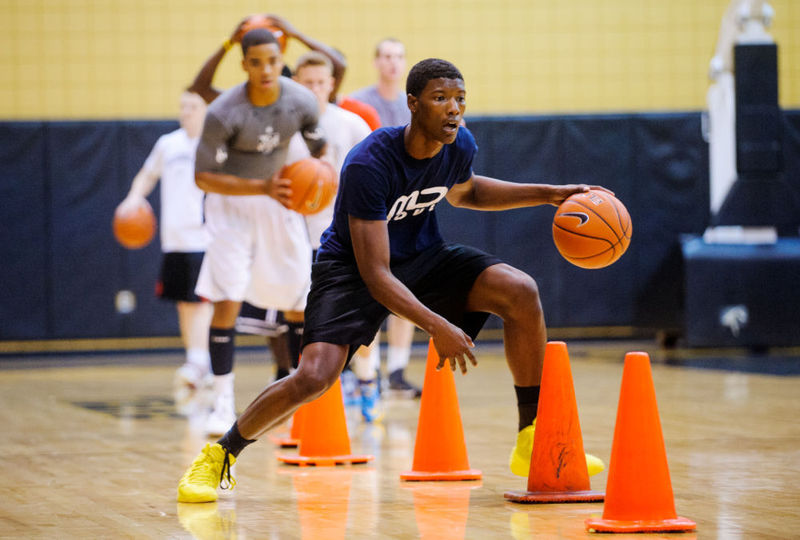 The attacker cannot be missed to the shield along the front line, if he moves slightly towards it, none of the partners will help the defender. The hand close to the end line insures the passage with the lead, the other one attacks the attacker.
The attacker cannot be missed to the shield along the front line, if he moves slightly towards it, none of the partners will help the defender. The hand close to the end line insures the passage with the lead, the other one attacks the attacker.
Do not give in to feints. If the attacker went to the end line where the defender took up position, you can meet him with his chest and show the referees that he knocked you down. Don't be afraid and learn to fall gently on your back.
If the attacker, despite the activity of the defender, lifted the ball for a throw, you should try to jump with him and prevent the throw. Do not stop working even when the opponent has already made a throw or pass. Do not turn away from him and block his path to the shield. When you take a step back, meet him with your face, and do not try to run after him. You should always be in these moments between the opponent and your shield.
4. If the defender is alone against two attackers, he tries to prevent the ball from being thrown from under the backboard and retreats with his back to his ring so that he can see both attackers.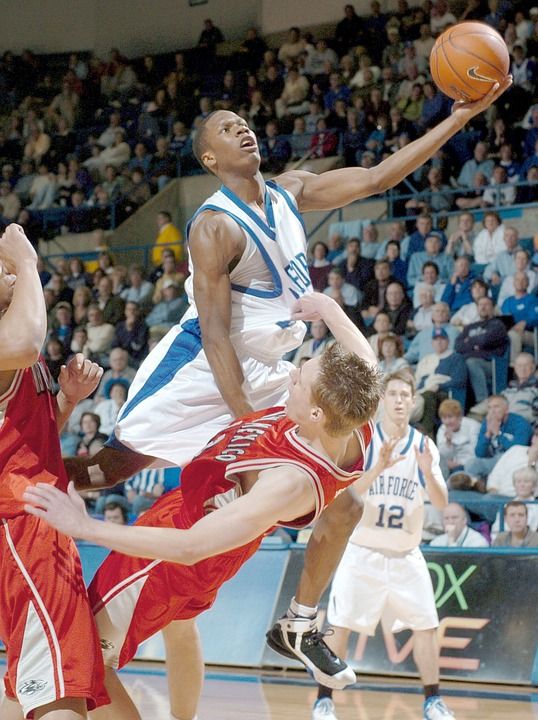 With false movements, he tries to stop the player with the ball and prevent him from making a pass to the opponent under the ring or in time for him in order to block the throw from a distance. Not allowing the ball to be thrown from under the shield, the defender will fulfill his mission.
With false movements, he tries to stop the player with the ball and prevent him from making a pass to the opponent under the ring or in time for him in order to block the throw from a distance. Not allowing the ball to be thrown from under the shield, the defender will fulfill his mission.
2x1 training on the spot and on the move develops reaction in defenders, teaches active arm movement, backward movement, composure and ability to intercept the ball.
5. Two defenders against three attackers - a common situation in any match, so the defenders, regardless of their position, being in the minority, must know their maneuver.
The front defender moves towards the dribbler to stop him at the top of the three-point offensive zone. He uses a feint, showing that making contact with this attacker is his main real task. At the same time, he should not get close to the opponent leading the ball. The rear defensive player takes a position on the free throw line, behind the front one and, after the pass from the dribbler, moves towards the player who received the ball - he is responsible for passing this player to the backboard or throwing from close range.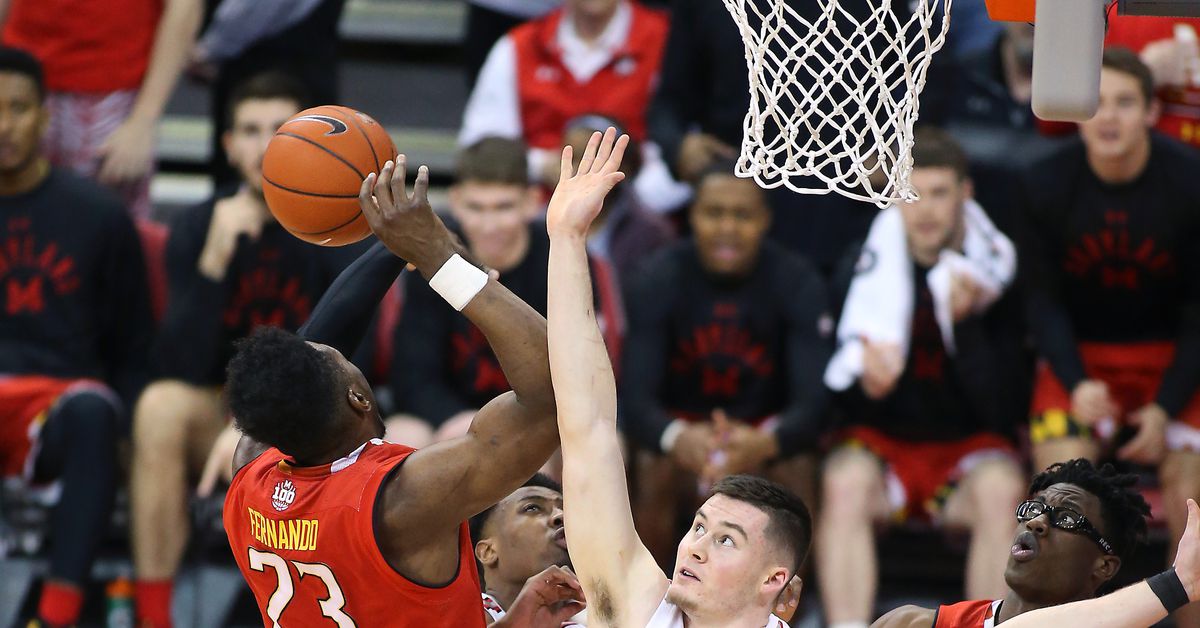 The front defender, meanwhile, quickly moves to the third striker under the shield, managing to prevent him from getting the ball. The task of the two defenders is to prevent the ball from being thrown from under the shield. Exercises 3x2, 4x3, 5x4 are a good school for practicing such actions. You can train them by attacking with two balls.
The front defender, meanwhile, quickly moves to the third striker under the shield, managing to prevent him from getting the ball. The task of the two defenders is to prevent the ball from being thrown from under the shield. Exercises 3x2, 4x3, 5x4 are a good school for practicing such actions. You can train them by attacking with two balls.
6. If three defenders are defending against four attackers, their actions are built as follows. If attacker XI has the ball, defender ?1 rushes towards him, defender ?2 is responsible for throwing and moving to attacker XZ's shield, defender ?3 moves to the shield. If attacker X2 receives the ball, defender ?1 tends to it. Defender ?3 is responsible for attacker X4, defender ?2 moves to the basket.
A 4x3 drill on the spot and on the move, with ball rebound, with one and two balls - a good rehearsal for a defense of three against four.
7. Today, not a single even very serious team imagines an attack without a combination of screens.
Coordination of actions of the team's defenders, warning about the impending screen determine the preparation of the team to fight the screens.
The guard guarding the screening player must warn his partner of the imminent threat. If the screen without the ball is made by attackers of the same height, there is no great danger of changing the defenders.
If the defenders want to avoid changing when screening from the side, the defender must turn towards the defender and step back, bypassing him from behind, which will not allow the attacker to pass to the backboard.
If the attacker screens from the blind side, from behind, the defender must open towards the defensive partner, turning sideways to him. This will make it difficult to set up a barrier.
8. If your partner puts a screen on the sniper when attacking from medium or long distances behind the defender and you did not have time to get out from under such a screen, a change is necessary: your partner switches to the sniper with his hand raised and prevents him from making a throw. You are left with a dangerous, taller opponent, and your task is to prevent him from getting the ball or picking up the ball after the throw.
You are left with a dangerous, taller opponent, and your task is to prevent him from getting the ball or picking up the ball after the throw.
It is difficult to do without the help of partners in this situation. In general, I am a supporter of the smallest shift with screens, because. this reduces individual responsibility and gives the attacker a chance to beat the defender.
9. If your player, while in possession of the ball, seeks to pass to a teammate who is close to him, you must step back and let your defensive partner slip, and then take an active position towards your attacker.
10. The defensive player should always try to get the dribbler to the touchline, into the corner of the court, stop him and turn his back to the backboard.
The second defender, seeing this situation, attacks the opponent with the ball from the other side. Both of them with active hand movements interfere with making an aimed pass. It is important that the rest of the defense players are ready, focused on intercepting the ball.-Step-5.jpg/aid43486-v4-728px-Play-21-(Basketball)-Step-5.jpg)
11. The USSR national team used the defense against the first pass in a fast break more than once against opponents who counterattack through a fast dribbler, sending him the first pass after picking up the ball from the backboard. So we often defended against the Spanish national team, where the ?1 dribbler was Carbolan or Salosobal.
Our team's tall center, who plays close to the backboard, whether it's Tkachenko, Sabonis or Belostenny, prevents the dribbler from making an accurate first pass. At the same time, our fast defender, for example, Homichujus, presses ?1 opponent and does not allow him to receive the ball. The other three of our players were to immediately return to their zone.
So often the counterattack of the Spanish national team failed, in which the Spaniards were especially dangerous and productive.
I must say that there are some significant differences between the game of our and American defenders. According to my conclusions, they are:
1.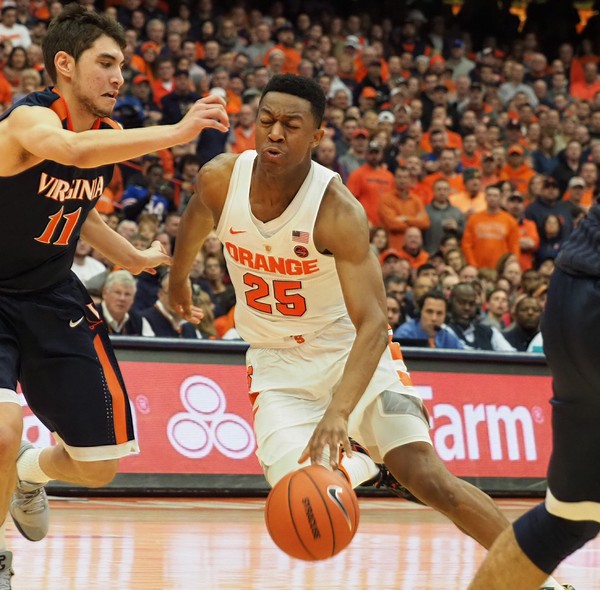 Americans on the defensive are always offensive, they are not afraid of a contact attack on the attacker in possession of the ball.
Americans on the defensive are always offensive, they are not afraid of a contact attack on the attacker in possession of the ball.
In a low stance with arms raised, the US defender seeks to hit the ball, prevent a pass from being made, not to mention a shot. If the attacker lifts the ball up, the defender immediately reacts to this: his hand rises up and seeks to interfere with any actions of the attacker. The attacker put the ball down - the defender immediately takes two quick steps back, preparing to prevent the opponent's pass without losing his defensive stance.
2. When active, the American defender never allows the attacker to pass with the ball through the center, into the middle, but constantly pushes him to the sideline. When an attacker is missed on the front line, teammates immediately come to the aid of the defender. Our tactic is, on the contrary, to close the baseline, where, as we believe, it is more difficult to provide team assistance. I think it's best to find a compromise here: train the safety net both in the middle of the three-second zone and when passing on the front.